CIPD Learning Outcomes and Assessment Criteria on Workplace Disputes and Conflict Resolution
VerifiedAdded on 2023/06/15
|36
|11874
|148
AI Summary
This article discusses the CIPD learning outcomes and assessment criteria on workplace disputes and conflict resolution. It covers topics such as the nature of employment law, official industrial action, conflict and misbehaviour, and the roles of external conciliation, mediation, and arbitration services.
Contribute Materials
Your contribution can guide someone’s learning journey. Share your
documents today.
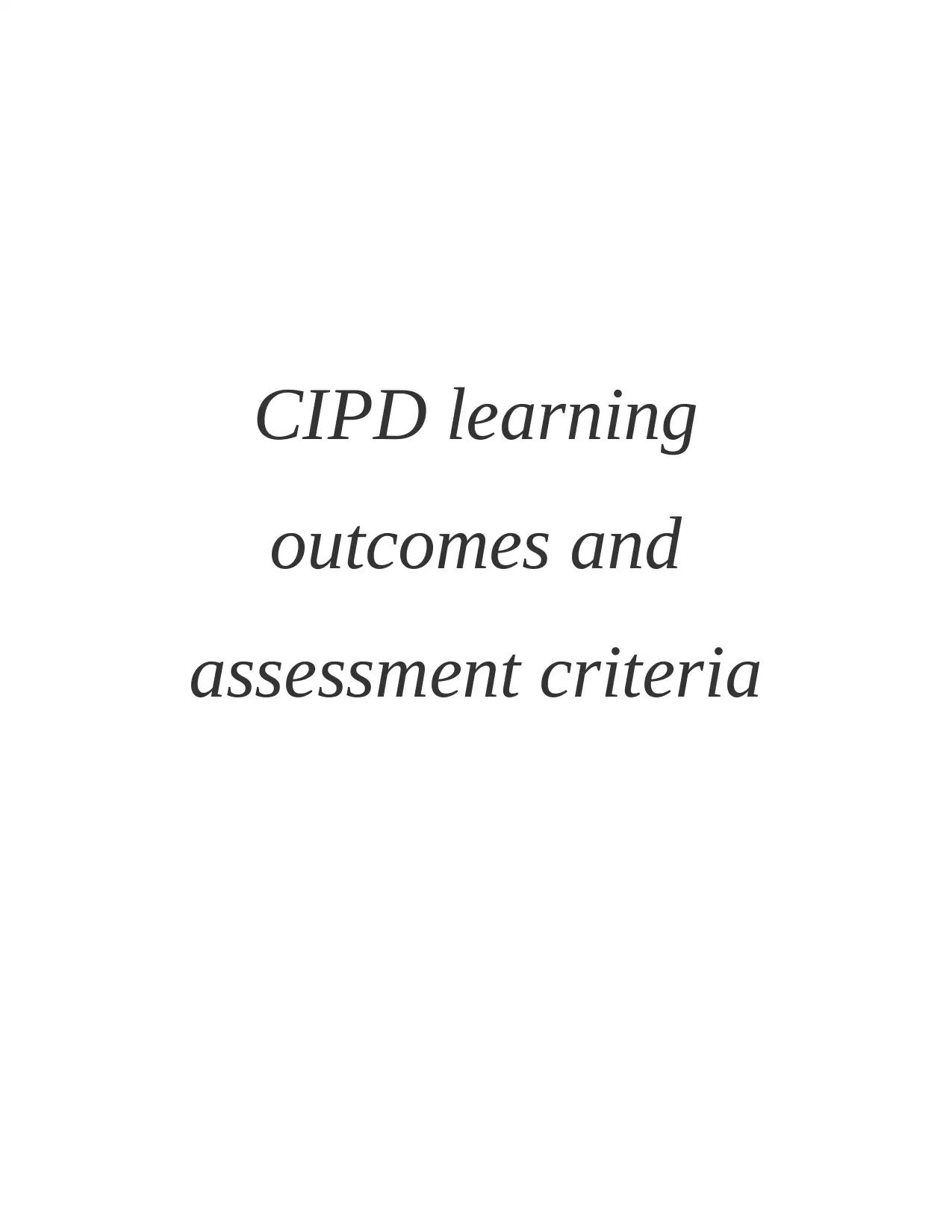
CIPD learning
outcomes and
assessment criteria
outcomes and
assessment criteria
Secure Best Marks with AI Grader
Need help grading? Try our AI Grader for instant feedback on your assignments.
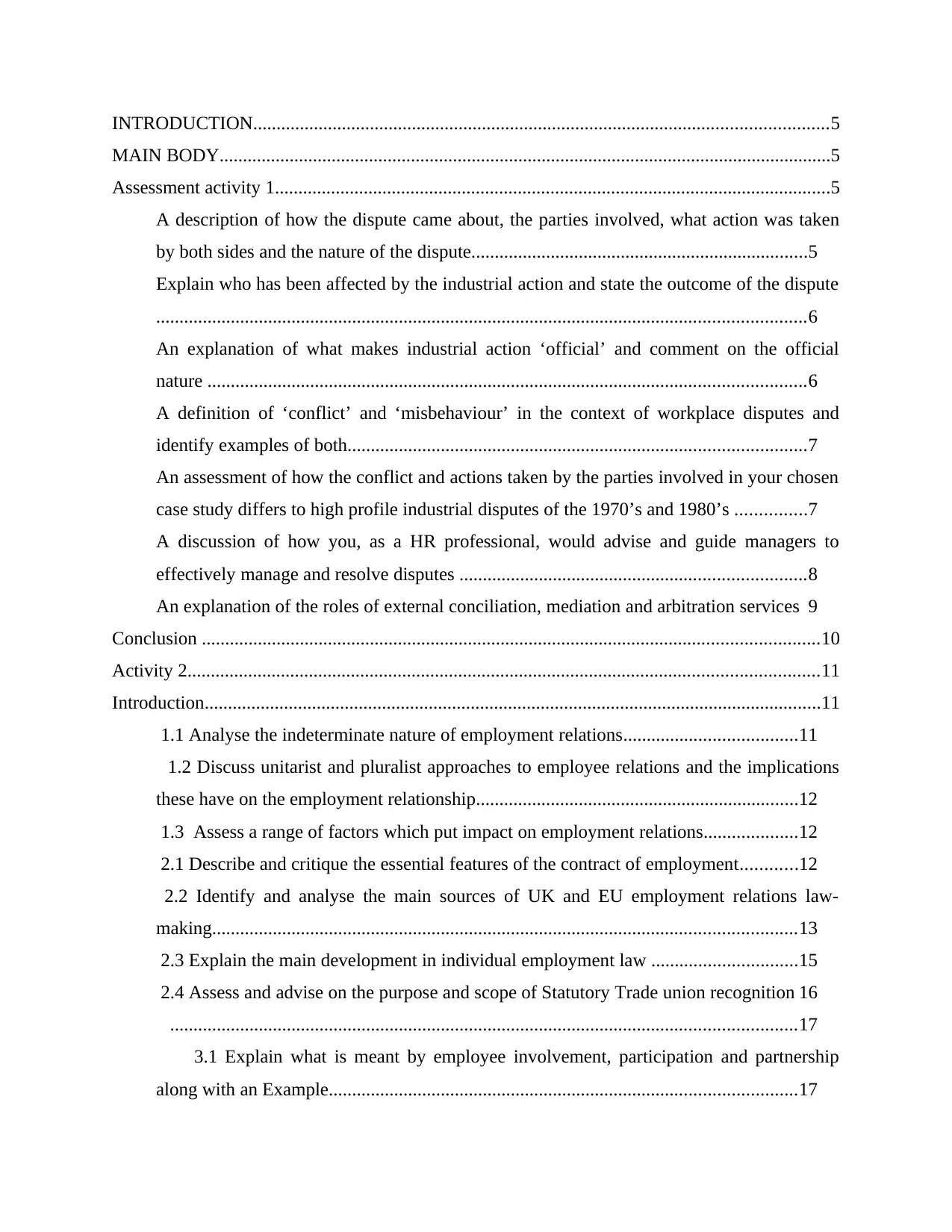
INTRODUCTION...........................................................................................................................5
MAIN BODY...................................................................................................................................5
Assessment activity 1.......................................................................................................................5
A description of how the dispute came about, the parties involved, what action was taken
by both sides and the nature of the dispute........................................................................5
Explain who has been affected by the industrial action and state the outcome of the dispute
...........................................................................................................................................6
An explanation of what makes industrial action ‘official’ and comment on the official
nature ................................................................................................................................6
A definition of ‘conflict’ and ‘misbehaviour’ in the context of workplace disputes and
identify examples of both..................................................................................................7
An assessment of how the conflict and actions taken by the parties involved in your chosen
case study differs to high profile industrial disputes of the 1970’s and 1980’s ...............7
A discussion of how you, as a HR professional, would advise and guide managers to
effectively manage and resolve disputes ..........................................................................8
An explanation of the roles of external conciliation, mediation and arbitration services 9
Conclusion ....................................................................................................................................10
Activity 2.......................................................................................................................................11
Introduction....................................................................................................................................11
1.1 Analyse the indeterminate nature of employment relations.....................................11
1.2 Discuss unitarist and pluralist approaches to employee relations and the implications
these have on the employment relationship.....................................................................12
1.3 Assess a range of factors which put impact on employment relations....................12
2.1 Describe and critique the essential features of the contract of employment............12
2.2 Identify and analyse the main sources of UK and EU employment relations law-
making.............................................................................................................................13
2.3 Explain the main development in individual employment law ...............................15
2.4 Assess and advise on the purpose and scope of Statutory Trade union recognition 16
......................................................................................................................................17
3.1 Explain what is meant by employee involvement, participation and partnership
along with an Example....................................................................................................17
MAIN BODY...................................................................................................................................5
Assessment activity 1.......................................................................................................................5
A description of how the dispute came about, the parties involved, what action was taken
by both sides and the nature of the dispute........................................................................5
Explain who has been affected by the industrial action and state the outcome of the dispute
...........................................................................................................................................6
An explanation of what makes industrial action ‘official’ and comment on the official
nature ................................................................................................................................6
A definition of ‘conflict’ and ‘misbehaviour’ in the context of workplace disputes and
identify examples of both..................................................................................................7
An assessment of how the conflict and actions taken by the parties involved in your chosen
case study differs to high profile industrial disputes of the 1970’s and 1980’s ...............7
A discussion of how you, as a HR professional, would advise and guide managers to
effectively manage and resolve disputes ..........................................................................8
An explanation of the roles of external conciliation, mediation and arbitration services 9
Conclusion ....................................................................................................................................10
Activity 2.......................................................................................................................................11
Introduction....................................................................................................................................11
1.1 Analyse the indeterminate nature of employment relations.....................................11
1.2 Discuss unitarist and pluralist approaches to employee relations and the implications
these have on the employment relationship.....................................................................12
1.3 Assess a range of factors which put impact on employment relations....................12
2.1 Describe and critique the essential features of the contract of employment............12
2.2 Identify and analyse the main sources of UK and EU employment relations law-
making.............................................................................................................................13
2.3 Explain the main development in individual employment law ...............................15
2.4 Assess and advise on the purpose and scope of Statutory Trade union recognition 16
......................................................................................................................................17
3.1 Explain what is meant by employee involvement, participation and partnership
along with an Example....................................................................................................17
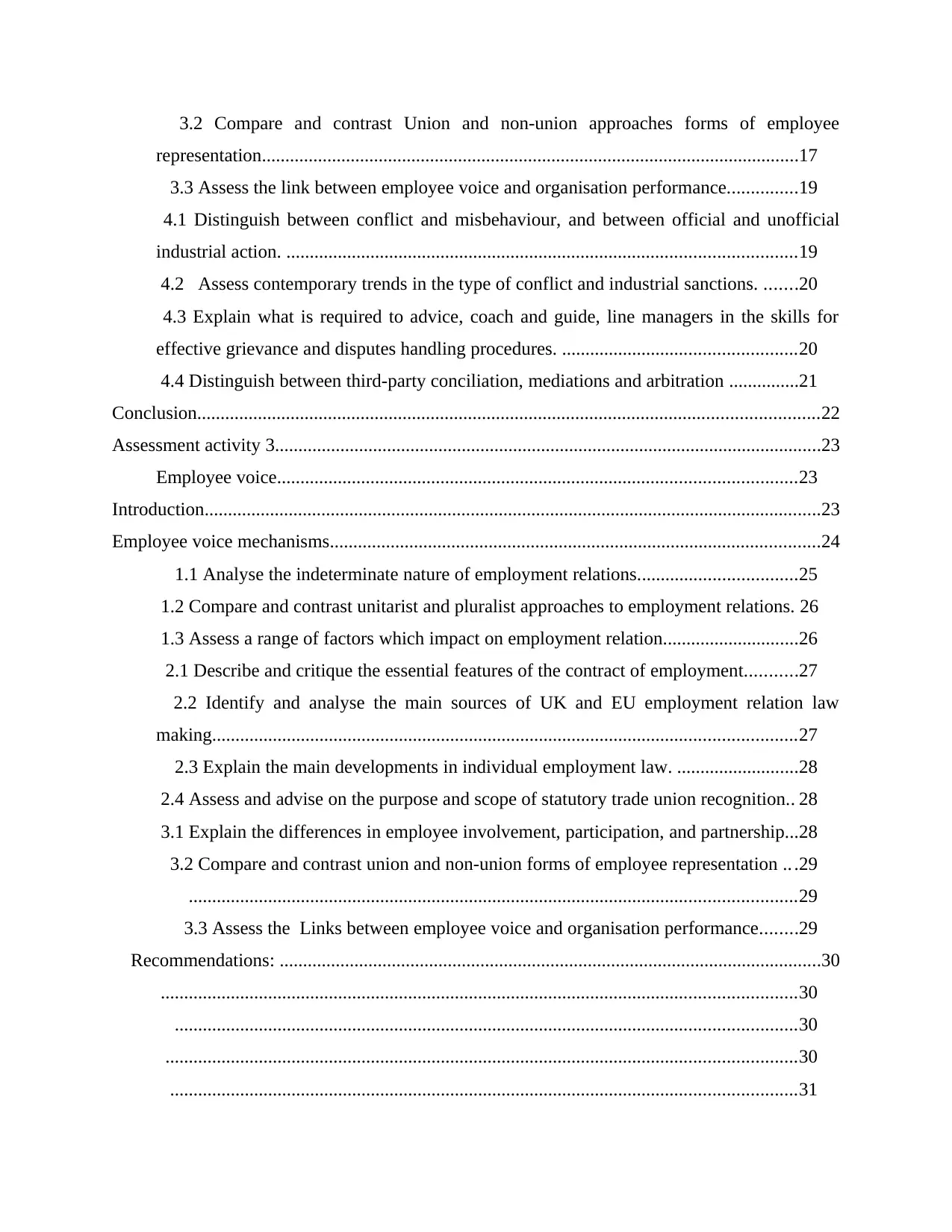
3.2 Compare and contrast Union and non-union approaches forms of employee
representation...................................................................................................................17
3.3 Assess the link between employee voice and organisation performance...............19
4.1 Distinguish between conflict and misbehaviour, and between official and unofficial
industrial action. .............................................................................................................19
4.2 Assess contemporary trends in the type of conflict and industrial sanctions. .......20
4.3 Explain what is required to advice, coach and guide, line managers in the skills for
effective grievance and disputes handling procedures. ..................................................20
4.4 Distinguish between third-party conciliation, mediations and arbitration ...............21
Conclusion.....................................................................................................................................22
Assessment activity 3.....................................................................................................................23
Employee voice...............................................................................................................23
Introduction....................................................................................................................................23
Employee voice mechanisms.........................................................................................................24
1.1 Analyse the indeterminate nature of employment relations..................................25
1.2 Compare and contrast unitarist and pluralist approaches to employment relations. 26
1.3 Assess a range of factors which impact on employment relation.............................26
2.1 Describe and critique the essential features of the contract of employment...........27
2.2 Identify and analyse the main sources of UK and EU employment relation law
making.............................................................................................................................27
2.3 Explain the main developments in individual employment law. ..........................28
2.4 Assess and advise on the purpose and scope of statutory trade union recognition.. 28
3.1 Explain the differences in employee involvement, participation, and partnership...28
3.2 Compare and contrast union and non-union forms of employee representation .. .29
..................................................................................................................................29
3.3 Assess the Links between employee voice and organisation performance........29
Recommendations: ....................................................................................................................30
........................................................................................................................................30
.....................................................................................................................................30
.......................................................................................................................................30
......................................................................................................................................31
representation...................................................................................................................17
3.3 Assess the link between employee voice and organisation performance...............19
4.1 Distinguish between conflict and misbehaviour, and between official and unofficial
industrial action. .............................................................................................................19
4.2 Assess contemporary trends in the type of conflict and industrial sanctions. .......20
4.3 Explain what is required to advice, coach and guide, line managers in the skills for
effective grievance and disputes handling procedures. ..................................................20
4.4 Distinguish between third-party conciliation, mediations and arbitration ...............21
Conclusion.....................................................................................................................................22
Assessment activity 3.....................................................................................................................23
Employee voice...............................................................................................................23
Introduction....................................................................................................................................23
Employee voice mechanisms.........................................................................................................24
1.1 Analyse the indeterminate nature of employment relations..................................25
1.2 Compare and contrast unitarist and pluralist approaches to employment relations. 26
1.3 Assess a range of factors which impact on employment relation.............................26
2.1 Describe and critique the essential features of the contract of employment...........27
2.2 Identify and analyse the main sources of UK and EU employment relation law
making.............................................................................................................................27
2.3 Explain the main developments in individual employment law. ..........................28
2.4 Assess and advise on the purpose and scope of statutory trade union recognition.. 28
3.1 Explain the differences in employee involvement, participation, and partnership...28
3.2 Compare and contrast union and non-union forms of employee representation .. .29
..................................................................................................................................29
3.3 Assess the Links between employee voice and organisation performance........29
Recommendations: ....................................................................................................................30
........................................................................................................................................30
.....................................................................................................................................30
.......................................................................................................................................30
......................................................................................................................................31

4.1 Distinguish between conflict and misbehaviour, and between official and unofficial
industrial action...............................................................................................................31
4.2 Assess contemporary trends in the type of conflict and industrial sanction..........31
4.3 Explain what is required to advise, coach and guide, line managers in the skills for
effective grievance and dispute handling procedures.....................................................32
4.4 Distinguish between third party conciliation , mediation and arbitration..............32
Conclusions....................................................................................................................................32
REFERENCES..............................................................................................................................34
industrial action...............................................................................................................31
4.2 Assess contemporary trends in the type of conflict and industrial sanction..........31
4.3 Explain what is required to advise, coach and guide, line managers in the skills for
effective grievance and dispute handling procedures.....................................................32
4.4 Distinguish between third party conciliation , mediation and arbitration..............32
Conclusions....................................................................................................................................32
REFERENCES..............................................................................................................................34
Paraphrase This Document
Need a fresh take? Get an instant paraphrase of this document with our AI Paraphraser
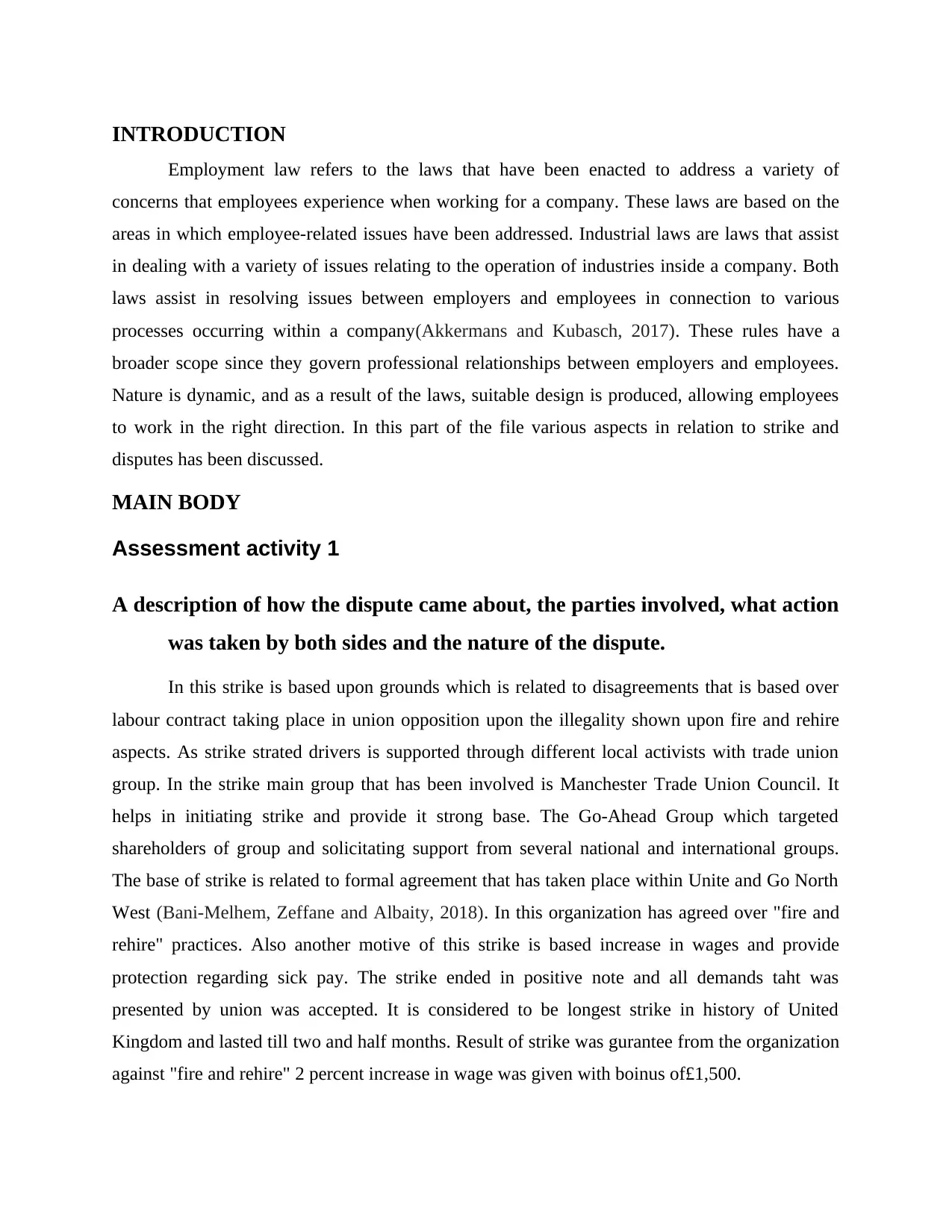
INTRODUCTION
Employment law refers to the laws that have been enacted to address a variety of
concerns that employees experience when working for a company. These laws are based on the
areas in which employee-related issues have been addressed. Industrial laws are laws that assist
in dealing with a variety of issues relating to the operation of industries inside a company. Both
laws assist in resolving issues between employers and employees in connection to various
processes occurring within a company(Akkermans and Kubasch, 2017). These rules have a
broader scope since they govern professional relationships between employers and employees.
Nature is dynamic, and as a result of the laws, suitable design is produced, allowing employees
to work in the right direction. In this part of the file various aspects in relation to strike and
disputes has been discussed.
MAIN BODY
Assessment activity 1
A description of how the dispute came about, the parties involved, what action
was taken by both sides and the nature of the dispute.
In this strike is based upon grounds which is related to disagreements that is based over
labour contract taking place in union opposition upon the illegality shown upon fire and rehire
aspects. As strike strated drivers is supported through different local activists with trade union
group. In the strike main group that has been involved is Manchester Trade Union Council. It
helps in initiating strike and provide it strong base. The Go-Ahead Group which targeted
shareholders of group and solicitating support from several national and international groups.
The base of strike is related to formal agreement that has taken place within Unite and Go North
West (Bani-Melhem, Zeffane and Albaity, 2018). In this organization has agreed over "fire and
rehire" practices. Also another motive of this strike is based increase in wages and provide
protection regarding sick pay. The strike ended in positive note and all demands taht was
presented by union was accepted. It is considered to be longest strike in history of United
Kingdom and lasted till two and half months. Result of strike was gurantee from the organization
against "fire and rehire" 2 percent increase in wage was given with boinus of£1,500.
Employment law refers to the laws that have been enacted to address a variety of
concerns that employees experience when working for a company. These laws are based on the
areas in which employee-related issues have been addressed. Industrial laws are laws that assist
in dealing with a variety of issues relating to the operation of industries inside a company. Both
laws assist in resolving issues between employers and employees in connection to various
processes occurring within a company(Akkermans and Kubasch, 2017). These rules have a
broader scope since they govern professional relationships between employers and employees.
Nature is dynamic, and as a result of the laws, suitable design is produced, allowing employees
to work in the right direction. In this part of the file various aspects in relation to strike and
disputes has been discussed.
MAIN BODY
Assessment activity 1
A description of how the dispute came about, the parties involved, what action
was taken by both sides and the nature of the dispute.
In this strike is based upon grounds which is related to disagreements that is based over
labour contract taking place in union opposition upon the illegality shown upon fire and rehire
aspects. As strike strated drivers is supported through different local activists with trade union
group. In the strike main group that has been involved is Manchester Trade Union Council. It
helps in initiating strike and provide it strong base. The Go-Ahead Group which targeted
shareholders of group and solicitating support from several national and international groups.
The base of strike is related to formal agreement that has taken place within Unite and Go North
West (Bani-Melhem, Zeffane and Albaity, 2018). In this organization has agreed over "fire and
rehire" practices. Also another motive of this strike is based increase in wages and provide
protection regarding sick pay. The strike ended in positive note and all demands taht was
presented by union was accepted. It is considered to be longest strike in history of United
Kingdom and lasted till two and half months. Result of strike was gurantee from the organization
against "fire and rehire" 2 percent increase in wage was given with boinus of£1,500.
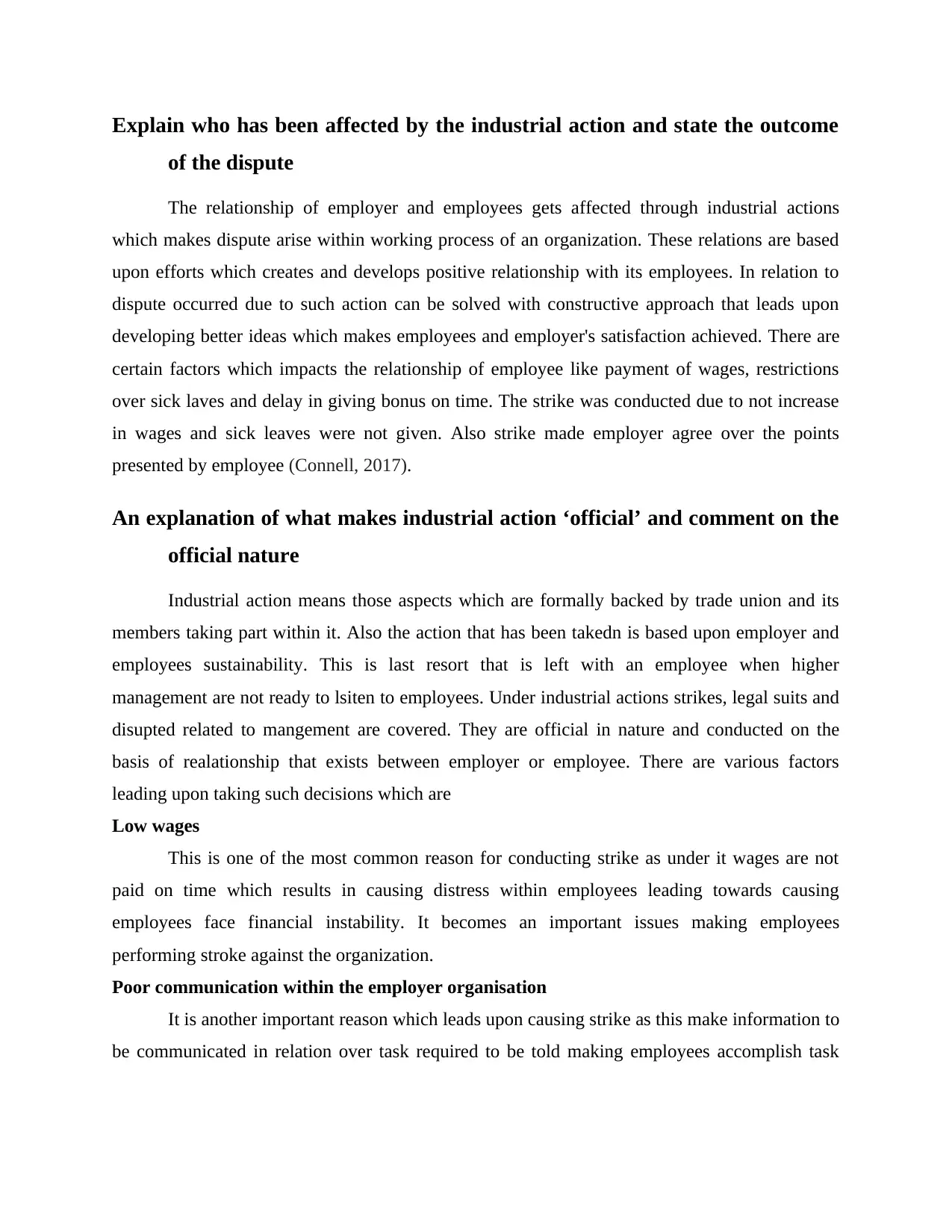
Explain who has been affected by the industrial action and state the outcome
of the dispute
The relationship of employer and employees gets affected through industrial actions
which makes dispute arise within working process of an organization. These relations are based
upon efforts which creates and develops positive relationship with its employees. In relation to
dispute occurred due to such action can be solved with constructive approach that leads upon
developing better ideas which makes employees and employer's satisfaction achieved. There are
certain factors which impacts the relationship of employee like payment of wages, restrictions
over sick laves and delay in giving bonus on time. The strike was conducted due to not increase
in wages and sick leaves were not given. Also strike made employer agree over the points
presented by employee (Connell, 2017).
An explanation of what makes industrial action ‘official’ and comment on the
official nature
Industrial action means those aspects which are formally backed by trade union and its
members taking part within it. Also the action that has been takedn is based upon employer and
employees sustainability. This is last resort that is left with an employee when higher
management are not ready to lsiten to employees. Under industrial actions strikes, legal suits and
disupted related to mangement are covered. They are official in nature and conducted on the
basis of realationship that exists between employer or employee. There are various factors
leading upon taking such decisions which are
Low wages
This is one of the most common reason for conducting strike as under it wages are not
paid on time which results in causing distress within employees leading towards causing
employees face financial instability. It becomes an important issues making employees
performing stroke against the organization.
Poor communication within the employer organisation
It is another important reason which leads upon causing strike as this make information to
be communicated in relation over task required to be told making employees accomplish task
of the dispute
The relationship of employer and employees gets affected through industrial actions
which makes dispute arise within working process of an organization. These relations are based
upon efforts which creates and develops positive relationship with its employees. In relation to
dispute occurred due to such action can be solved with constructive approach that leads upon
developing better ideas which makes employees and employer's satisfaction achieved. There are
certain factors which impacts the relationship of employee like payment of wages, restrictions
over sick laves and delay in giving bonus on time. The strike was conducted due to not increase
in wages and sick leaves were not given. Also strike made employer agree over the points
presented by employee (Connell, 2017).
An explanation of what makes industrial action ‘official’ and comment on the
official nature
Industrial action means those aspects which are formally backed by trade union and its
members taking part within it. Also the action that has been takedn is based upon employer and
employees sustainability. This is last resort that is left with an employee when higher
management are not ready to lsiten to employees. Under industrial actions strikes, legal suits and
disupted related to mangement are covered. They are official in nature and conducted on the
basis of realationship that exists between employer or employee. There are various factors
leading upon taking such decisions which are
Low wages
This is one of the most common reason for conducting strike as under it wages are not
paid on time which results in causing distress within employees leading towards causing
employees face financial instability. It becomes an important issues making employees
performing stroke against the organization.
Poor communication within the employer organisation
It is another important reason which leads upon causing strike as this make information to
be communicated in relation over task required to be told making employees accomplish task

within time limit specified. This causes employees to loose there job and lead towards unfair
dismissal which has been barred within employee's right act 1995.
Disparity with increases awarded to senior people
Employees of trade union should be able to make negotiation done when argument over
limited wages increases. The trade union make discussion done with Boards of Directors that has
declared making payments increased of the employees. This is an important aspects which helps
senior employee's develop working tendency within them (Cooper, 2019). In the above dispute
the strike took place due to low wages and disparity with increases awarded. It has important role
to play making organization agree upon terms in relation to bonus perspective.
A definition of ‘conflict’ and ‘misbehaviour’ in the context of workplace
disputes and identify examples of both.
Organizational conflict which has been taking place at workplace making takes place
through actual needs of employees with the facyirs that is related within an organization.
Conflict can be based upon various factors and forms present within an organization. Conflict
also based over sharp disagreement or opposition of intrests and ideas upon wokring place where
people work together as conflict or natural occurence. This caused due to team low team moral,
increase in absenteeism and decrease in productivity. Misbehaviour menas that kind of actions
which is not ethical in nature and causes disturbance within working ernvironment of an
organization. The acts is based upon making dispute to be solved that has been taking place
within an organization. In the secenatio strike has taken place due to various perspective that is
based upon wages , bonus, hiring and firing.
An assessment of how the conflict and actions taken by the parties involved in
your chosen case study differs to high profile industrial disputes of the
1970’s and 1980’s
In the modern world workers and employees after leaving particular job with number of
options get absorbed. This has taken place due to influence which has been caused due influence
upon factories and countries. It has also made rise within the number of jobs for inhabitation of
host country. There are two main trends that has taken place they are merger and acquisition
dismissal which has been barred within employee's right act 1995.
Disparity with increases awarded to senior people
Employees of trade union should be able to make negotiation done when argument over
limited wages increases. The trade union make discussion done with Boards of Directors that has
declared making payments increased of the employees. This is an important aspects which helps
senior employee's develop working tendency within them (Cooper, 2019). In the above dispute
the strike took place due to low wages and disparity with increases awarded. It has important role
to play making organization agree upon terms in relation to bonus perspective.
A definition of ‘conflict’ and ‘misbehaviour’ in the context of workplace
disputes and identify examples of both.
Organizational conflict which has been taking place at workplace making takes place
through actual needs of employees with the facyirs that is related within an organization.
Conflict can be based upon various factors and forms present within an organization. Conflict
also based over sharp disagreement or opposition of intrests and ideas upon wokring place where
people work together as conflict or natural occurence. This caused due to team low team moral,
increase in absenteeism and decrease in productivity. Misbehaviour menas that kind of actions
which is not ethical in nature and causes disturbance within working ernvironment of an
organization. The acts is based upon making dispute to be solved that has been taking place
within an organization. In the secenatio strike has taken place due to various perspective that is
based upon wages , bonus, hiring and firing.
An assessment of how the conflict and actions taken by the parties involved in
your chosen case study differs to high profile industrial disputes of the
1970’s and 1980’s
In the modern world workers and employees after leaving particular job with number of
options get absorbed. This has taken place due to influence which has been caused due influence
upon factories and countries. It has also made rise within the number of jobs for inhabitation of
host country. There are two main trends that has taken place they are merger and acquisition
Secure Best Marks with AI Grader
Need help grading? Try our AI Grader for instant feedback on your assignments.
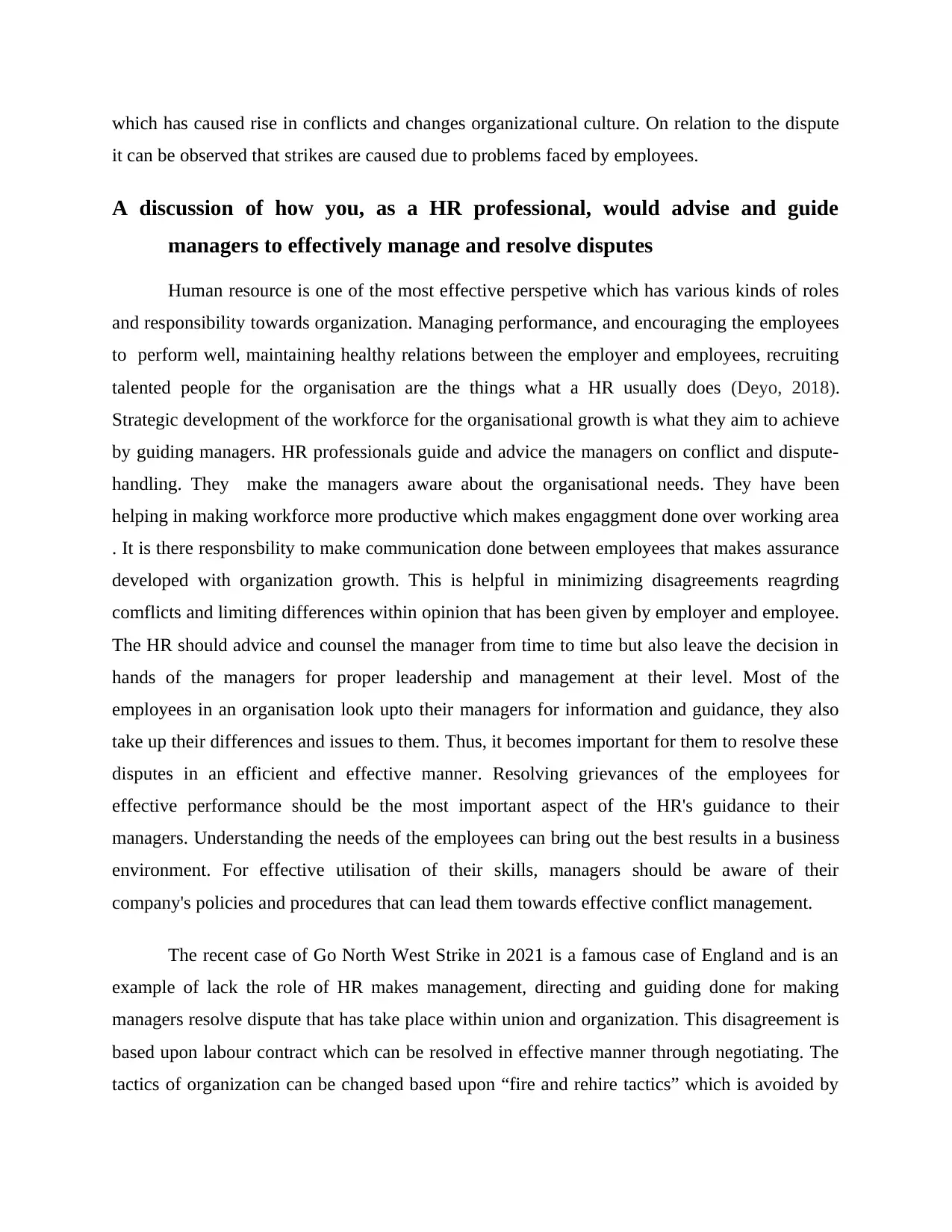
which has caused rise in conflicts and changes organizational culture. On relation to the dispute
it can be observed that strikes are caused due to problems faced by employees.
A discussion of how you, as a HR professional, would advise and guide
managers to effectively manage and resolve disputes
Human resource is one of the most effective perspetive which has various kinds of roles
and responsibility towards organization. Managing performance, and encouraging the employees
to perform well, maintaining healthy relations between the employer and employees, recruiting
talented people for the organisation are the things what a HR usually does (Deyo, 2018).
Strategic development of the workforce for the organisational growth is what they aim to achieve
by guiding managers. HR professionals guide and advice the managers on conflict and dispute-
handling. They make the managers aware about the organisational needs. They have been
helping in making workforce more productive which makes engaggment done over working area
. It is there responsbility to make communication done between employees that makes assurance
developed with organization growth. This is helpful in minimizing disagreements reagrding
comflicts and limiting differences within opinion that has been given by employer and employee.
The HR should advice and counsel the manager from time to time but also leave the decision in
hands of the managers for proper leadership and management at their level. Most of the
employees in an organisation look upto their managers for information and guidance, they also
take up their differences and issues to them. Thus, it becomes important for them to resolve these
disputes in an efficient and effective manner. Resolving grievances of the employees for
effective performance should be the most important aspect of the HR's guidance to their
managers. Understanding the needs of the employees can bring out the best results in a business
environment. For effective utilisation of their skills, managers should be aware of their
company's policies and procedures that can lead them towards effective conflict management.
The recent case of Go North West Strike in 2021 is a famous case of England and is an
example of lack the role of HR makes management, directing and guiding done for making
managers resolve dispute that has take place within union and organization. This disagreement is
based upon labour contract which can be resolved in effective manner through negotiating. The
tactics of organization can be changed based upon “fire and rehire tactics” which is avoided by
it can be observed that strikes are caused due to problems faced by employees.
A discussion of how you, as a HR professional, would advise and guide
managers to effectively manage and resolve disputes
Human resource is one of the most effective perspetive which has various kinds of roles
and responsibility towards organization. Managing performance, and encouraging the employees
to perform well, maintaining healthy relations between the employer and employees, recruiting
talented people for the organisation are the things what a HR usually does (Deyo, 2018).
Strategic development of the workforce for the organisational growth is what they aim to achieve
by guiding managers. HR professionals guide and advice the managers on conflict and dispute-
handling. They make the managers aware about the organisational needs. They have been
helping in making workforce more productive which makes engaggment done over working area
. It is there responsbility to make communication done between employees that makes assurance
developed with organization growth. This is helpful in minimizing disagreements reagrding
comflicts and limiting differences within opinion that has been given by employer and employee.
The HR should advice and counsel the manager from time to time but also leave the decision in
hands of the managers for proper leadership and management at their level. Most of the
employees in an organisation look upto their managers for information and guidance, they also
take up their differences and issues to them. Thus, it becomes important for them to resolve these
disputes in an efficient and effective manner. Resolving grievances of the employees for
effective performance should be the most important aspect of the HR's guidance to their
managers. Understanding the needs of the employees can bring out the best results in a business
environment. For effective utilisation of their skills, managers should be aware of their
company's policies and procedures that can lead them towards effective conflict management.
The recent case of Go North West Strike in 2021 is a famous case of England and is an
example of lack the role of HR makes management, directing and guiding done for making
managers resolve dispute that has take place within union and organization. This disagreement is
based upon labour contract which can be resolved in effective manner through negotiating. The
tactics of organization can be changed based upon “fire and rehire tactics” which is avoided by

managers through effectively communicating the needs of both the parties to each other. The
strike by the union which resulted in the chaos was attempted to be resolved by negotiations but
that could not help and thus they were later resolved by discussions which resulted into an
agreement between the two parties. The strike lasted for more than two months. This scenario
would have been different under the proper HR advice to the managers of the Company.
Thus HR which is commonly known as the Human Resource Management must know
the challenges that makes opportunities generated within the role of management of human
resource taking place within an organization.
An explanation of the roles of external conciliation, mediation and arbitration
services
In order to resolve a dispute related to workplace rather than directly going for a legal
remedy there are many more options available which are both convenient and effective such as
Arbitration, Mediation and Conciliation. This is based upon solving dispute without going to
court since these methods has gained popularity as they leads towards making development done
within legal persistence making fair judgement produced without following long process of
litigation. Mediation and conciliation makes common point of agreement taken place between
parties with positive set of mind. Arbitration has helps in solving dispute which are based over
contract and torts laws in order to make parties follow decision passed by arbitrator.
Mediation is where one person who acts as a mediator in an impartial way for both the
concerning parties by making them come to an conclusion which is common in nature making
both parties agree over points. This process of dispute resolution is usually quicker and less
expensive than going to the court and taking legal action. Further conciliation is more or less
similar to mediation. Generally it is used when there is some specific legal dispute rather than
more general problem. In conciliation the main task of conciliator is of just to encourage both the
concerned parties to come to the common result. The conciliator acts as an independent and
impartial person and is bound to keep all the discussions done on his table as confidential. He
just assists the parties in making their thoughts clear and look at ideas that they have for resoling
the problem.
strike by the union which resulted in the chaos was attempted to be resolved by negotiations but
that could not help and thus they were later resolved by discussions which resulted into an
agreement between the two parties. The strike lasted for more than two months. This scenario
would have been different under the proper HR advice to the managers of the Company.
Thus HR which is commonly known as the Human Resource Management must know
the challenges that makes opportunities generated within the role of management of human
resource taking place within an organization.
An explanation of the roles of external conciliation, mediation and arbitration
services
In order to resolve a dispute related to workplace rather than directly going for a legal
remedy there are many more options available which are both convenient and effective such as
Arbitration, Mediation and Conciliation. This is based upon solving dispute without going to
court since these methods has gained popularity as they leads towards making development done
within legal persistence making fair judgement produced without following long process of
litigation. Mediation and conciliation makes common point of agreement taken place between
parties with positive set of mind. Arbitration has helps in solving dispute which are based over
contract and torts laws in order to make parties follow decision passed by arbitrator.
Mediation is where one person who acts as a mediator in an impartial way for both the
concerning parties by making them come to an conclusion which is common in nature making
both parties agree over points. This process of dispute resolution is usually quicker and less
expensive than going to the court and taking legal action. Further conciliation is more or less
similar to mediation. Generally it is used when there is some specific legal dispute rather than
more general problem. In conciliation the main task of conciliator is of just to encourage both the
concerned parties to come to the common result. The conciliator acts as an independent and
impartial person and is bound to keep all the discussions done on his table as confidential. He
just assists the parties in making their thoughts clear and look at ideas that they have for resoling
the problem.
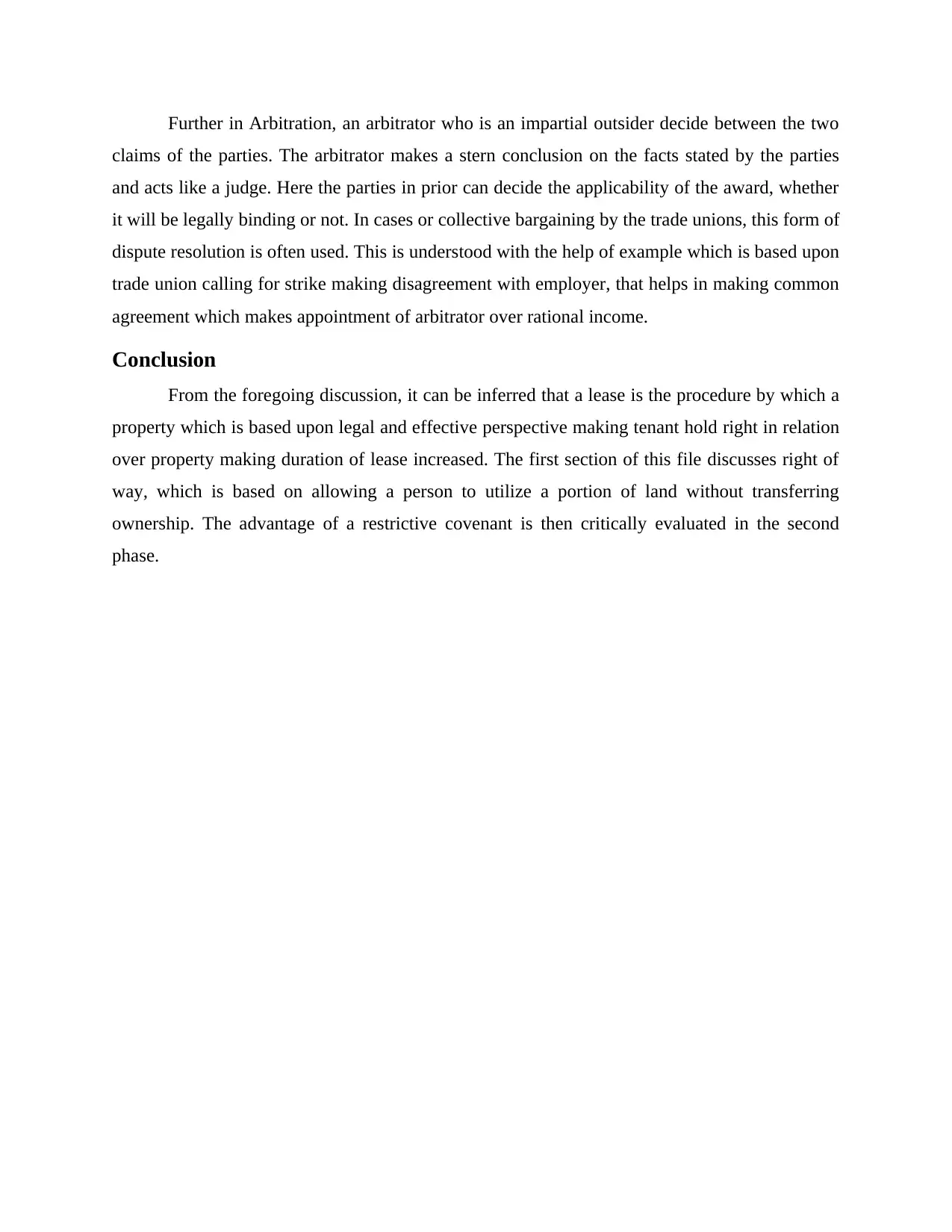
Further in Arbitration, an arbitrator who is an impartial outsider decide between the two
claims of the parties. The arbitrator makes a stern conclusion on the facts stated by the parties
and acts like a judge. Here the parties in prior can decide the applicability of the award, whether
it will be legally binding or not. In cases or collective bargaining by the trade unions, this form of
dispute resolution is often used. This is understood with the help of example which is based upon
trade union calling for strike making disagreement with employer, that helps in making common
agreement which makes appointment of arbitrator over rational income.
Conclusion
From the foregoing discussion, it can be inferred that a lease is the procedure by which a
property which is based upon legal and effective perspective making tenant hold right in relation
over property making duration of lease increased. The first section of this file discusses right of
way, which is based on allowing a person to utilize a portion of land without transferring
ownership. The advantage of a restrictive covenant is then critically evaluated in the second
phase.
claims of the parties. The arbitrator makes a stern conclusion on the facts stated by the parties
and acts like a judge. Here the parties in prior can decide the applicability of the award, whether
it will be legally binding or not. In cases or collective bargaining by the trade unions, this form of
dispute resolution is often used. This is understood with the help of example which is based upon
trade union calling for strike making disagreement with employer, that helps in making common
agreement which makes appointment of arbitrator over rational income.
Conclusion
From the foregoing discussion, it can be inferred that a lease is the procedure by which a
property which is based upon legal and effective perspective making tenant hold right in relation
over property making duration of lease increased. The first section of this file discusses right of
way, which is based on allowing a person to utilize a portion of land without transferring
ownership. The advantage of a restrictive covenant is then critically evaluated in the second
phase.
Paraphrase This Document
Need a fresh take? Get an instant paraphrase of this document with our AI Paraphraser
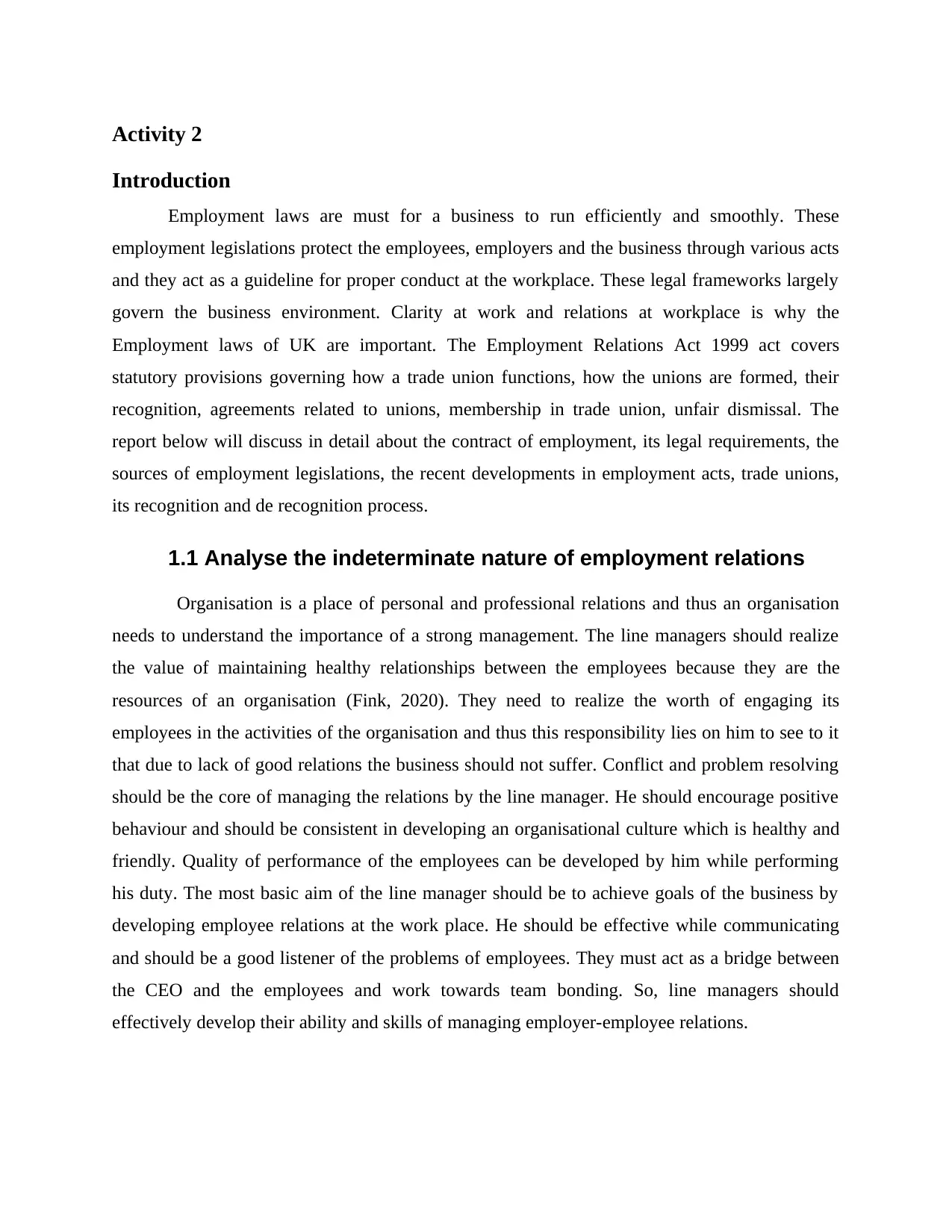
Activity 2
Introduction
Employment laws are must for a business to run efficiently and smoothly. These
employment legislations protect the employees, employers and the business through various acts
and they act as a guideline for proper conduct at the workplace. These legal frameworks largely
govern the business environment. Clarity at work and relations at workplace is why the
Employment laws of UK are important. The Employment Relations Act 1999 act covers
statutory provisions governing how a trade union functions, how the unions are formed, their
recognition, agreements related to unions, membership in trade union, unfair dismissal. The
report below will discuss in detail about the contract of employment, its legal requirements, the
sources of employment legislations, the recent developments in employment acts, trade unions,
its recognition and de recognition process.
1.1 Analyse the indeterminate nature of employment relations
Organisation is a place of personal and professional relations and thus an organisation
needs to understand the importance of a strong management. The line managers should realize
the value of maintaining healthy relationships between the employees because they are the
resources of an organisation (Fink, 2020). They need to realize the worth of engaging its
employees in the activities of the organisation and thus this responsibility lies on him to see to it
that due to lack of good relations the business should not suffer. Conflict and problem resolving
should be the core of managing the relations by the line manager. He should encourage positive
behaviour and should be consistent in developing an organisational culture which is healthy and
friendly. Quality of performance of the employees can be developed by him while performing
his duty. The most basic aim of the line manager should be to achieve goals of the business by
developing employee relations at the work place. He should be effective while communicating
and should be a good listener of the problems of employees. They must act as a bridge between
the CEO and the employees and work towards team bonding. So, line managers should
effectively develop their ability and skills of managing employer-employee relations.
Introduction
Employment laws are must for a business to run efficiently and smoothly. These
employment legislations protect the employees, employers and the business through various acts
and they act as a guideline for proper conduct at the workplace. These legal frameworks largely
govern the business environment. Clarity at work and relations at workplace is why the
Employment laws of UK are important. The Employment Relations Act 1999 act covers
statutory provisions governing how a trade union functions, how the unions are formed, their
recognition, agreements related to unions, membership in trade union, unfair dismissal. The
report below will discuss in detail about the contract of employment, its legal requirements, the
sources of employment legislations, the recent developments in employment acts, trade unions,
its recognition and de recognition process.
1.1 Analyse the indeterminate nature of employment relations
Organisation is a place of personal and professional relations and thus an organisation
needs to understand the importance of a strong management. The line managers should realize
the value of maintaining healthy relationships between the employees because they are the
resources of an organisation (Fink, 2020). They need to realize the worth of engaging its
employees in the activities of the organisation and thus this responsibility lies on him to see to it
that due to lack of good relations the business should not suffer. Conflict and problem resolving
should be the core of managing the relations by the line manager. He should encourage positive
behaviour and should be consistent in developing an organisational culture which is healthy and
friendly. Quality of performance of the employees can be developed by him while performing
his duty. The most basic aim of the line manager should be to achieve goals of the business by
developing employee relations at the work place. He should be effective while communicating
and should be a good listener of the problems of employees. They must act as a bridge between
the CEO and the employees and work towards team bonding. So, line managers should
effectively develop their ability and skills of managing employer-employee relations.
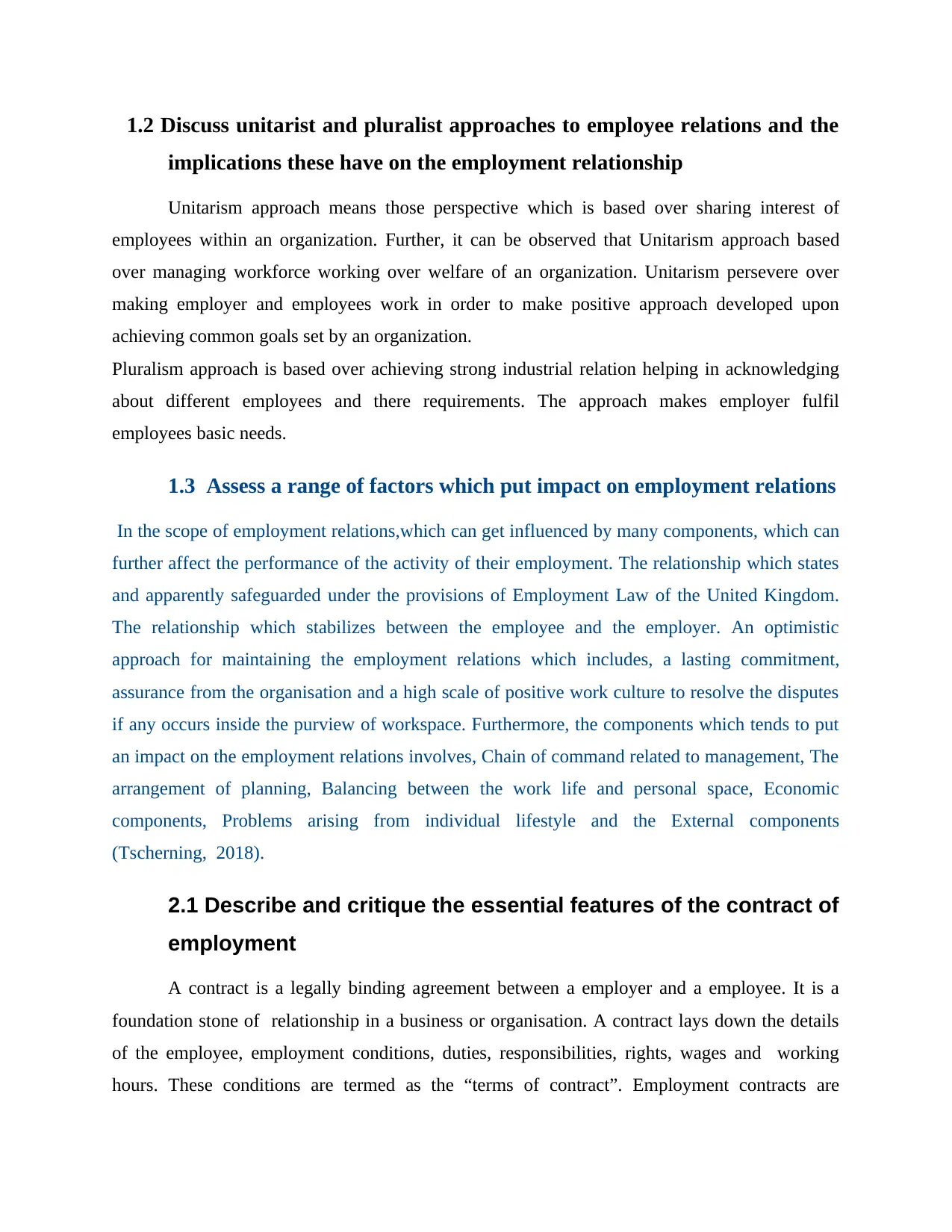
1.2 Discuss unitarist and pluralist approaches to employee relations and the
implications these have on the employment relationship
Unitarism approach means those perspective which is based over sharing interest of
employees within an organization. Further, it can be observed that Unitarism approach based
over managing workforce working over welfare of an organization. Unitarism persevere over
making employer and employees work in order to make positive approach developed upon
achieving common goals set by an organization.
Pluralism approach is based over achieving strong industrial relation helping in acknowledging
about different employees and there requirements. The approach makes employer fulfil
employees basic needs.
1.3 Assess a range of factors which put impact on employment relations
In the scope of employment relations,which can get influenced by many components, which can
further affect the performance of the activity of their employment. The relationship which states
and apparently safeguarded under the provisions of Employment Law of the United Kingdom.
The relationship which stabilizes between the employee and the employer. An optimistic
approach for maintaining the employment relations which includes, a lasting commitment,
assurance from the organisation and a high scale of positive work culture to resolve the disputes
if any occurs inside the purview of workspace. Furthermore, the components which tends to put
an impact on the employment relations involves, Chain of command related to management, The
arrangement of planning, Balancing between the work life and personal space, Economic
components, Problems arising from individual lifestyle and the External components
(Tscherning, 2018).
2.1 Describe and critique the essential features of the contract of
employment
A contract is a legally binding agreement between a employer and a employee. It is a
foundation stone of relationship in a business or organisation. A contract lays down the details
of the employee, employment conditions, duties, responsibilities, rights, wages and working
hours. These conditions are termed as the “terms of contract”. Employment contracts are
implications these have on the employment relationship
Unitarism approach means those perspective which is based over sharing interest of
employees within an organization. Further, it can be observed that Unitarism approach based
over managing workforce working over welfare of an organization. Unitarism persevere over
making employer and employees work in order to make positive approach developed upon
achieving common goals set by an organization.
Pluralism approach is based over achieving strong industrial relation helping in acknowledging
about different employees and there requirements. The approach makes employer fulfil
employees basic needs.
1.3 Assess a range of factors which put impact on employment relations
In the scope of employment relations,which can get influenced by many components, which can
further affect the performance of the activity of their employment. The relationship which states
and apparently safeguarded under the provisions of Employment Law of the United Kingdom.
The relationship which stabilizes between the employee and the employer. An optimistic
approach for maintaining the employment relations which includes, a lasting commitment,
assurance from the organisation and a high scale of positive work culture to resolve the disputes
if any occurs inside the purview of workspace. Furthermore, the components which tends to put
an impact on the employment relations involves, Chain of command related to management, The
arrangement of planning, Balancing between the work life and personal space, Economic
components, Problems arising from individual lifestyle and the External components
(Tscherning, 2018).
2.1 Describe and critique the essential features of the contract of
employment
A contract is a legally binding agreement between a employer and a employee. It is a
foundation stone of relationship in a business or organisation. A contract lays down the details
of the employee, employment conditions, duties, responsibilities, rights, wages and working
hours. These conditions are termed as the “terms of contract”. Employment contracts are
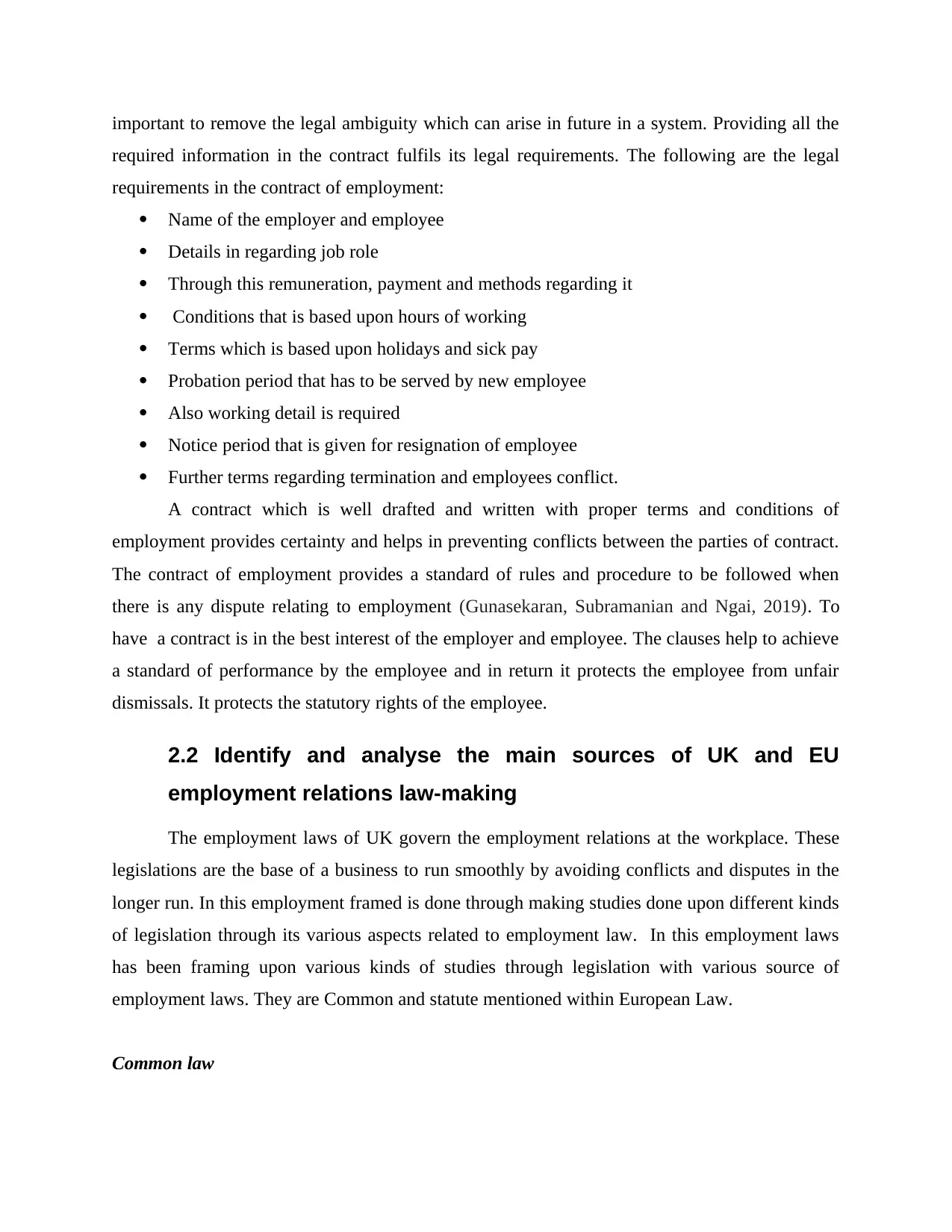
important to remove the legal ambiguity which can arise in future in a system. Providing all the
required information in the contract fulfils its legal requirements. The following are the legal
requirements in the contract of employment:
Name of the employer and employee
Details in regarding job role
Through this remuneration, payment and methods regarding it
Conditions that is based upon hours of working
Terms which is based upon holidays and sick pay
Probation period that has to be served by new employee
Also working detail is required
Notice period that is given for resignation of employee
Further terms regarding termination and employees conflict.
A contract which is well drafted and written with proper terms and conditions of
employment provides certainty and helps in preventing conflicts between the parties of contract.
The contract of employment provides a standard of rules and procedure to be followed when
there is any dispute relating to employment (Gunasekaran, Subramanian and Ngai, 2019). To
have a contract is in the best interest of the employer and employee. The clauses help to achieve
a standard of performance by the employee and in return it protects the employee from unfair
dismissals. It protects the statutory rights of the employee.
2.2 Identify and analyse the main sources of UK and EU
employment relations law-making
The employment laws of UK govern the employment relations at the workplace. These
legislations are the base of a business to run smoothly by avoiding conflicts and disputes in the
longer run. In this employment framed is done through making studies done upon different kinds
of legislation through its various aspects related to employment law. In this employment laws
has been framing upon various kinds of studies through legislation with various source of
employment laws. They are Common and statute mentioned within European Law.
Common law
required information in the contract fulfils its legal requirements. The following are the legal
requirements in the contract of employment:
Name of the employer and employee
Details in regarding job role
Through this remuneration, payment and methods regarding it
Conditions that is based upon hours of working
Terms which is based upon holidays and sick pay
Probation period that has to be served by new employee
Also working detail is required
Notice period that is given for resignation of employee
Further terms regarding termination and employees conflict.
A contract which is well drafted and written with proper terms and conditions of
employment provides certainty and helps in preventing conflicts between the parties of contract.
The contract of employment provides a standard of rules and procedure to be followed when
there is any dispute relating to employment (Gunasekaran, Subramanian and Ngai, 2019). To
have a contract is in the best interest of the employer and employee. The clauses help to achieve
a standard of performance by the employee and in return it protects the employee from unfair
dismissals. It protects the statutory rights of the employee.
2.2 Identify and analyse the main sources of UK and EU
employment relations law-making
The employment laws of UK govern the employment relations at the workplace. These
legislations are the base of a business to run smoothly by avoiding conflicts and disputes in the
longer run. In this employment framed is done through making studies done upon different kinds
of legislation through its various aspects related to employment law. In this employment laws
has been framing upon various kinds of studies through legislation with various source of
employment laws. They are Common and statute mentioned within European Law.
Common law
Secure Best Marks with AI Grader
Need help grading? Try our AI Grader for instant feedback on your assignments.
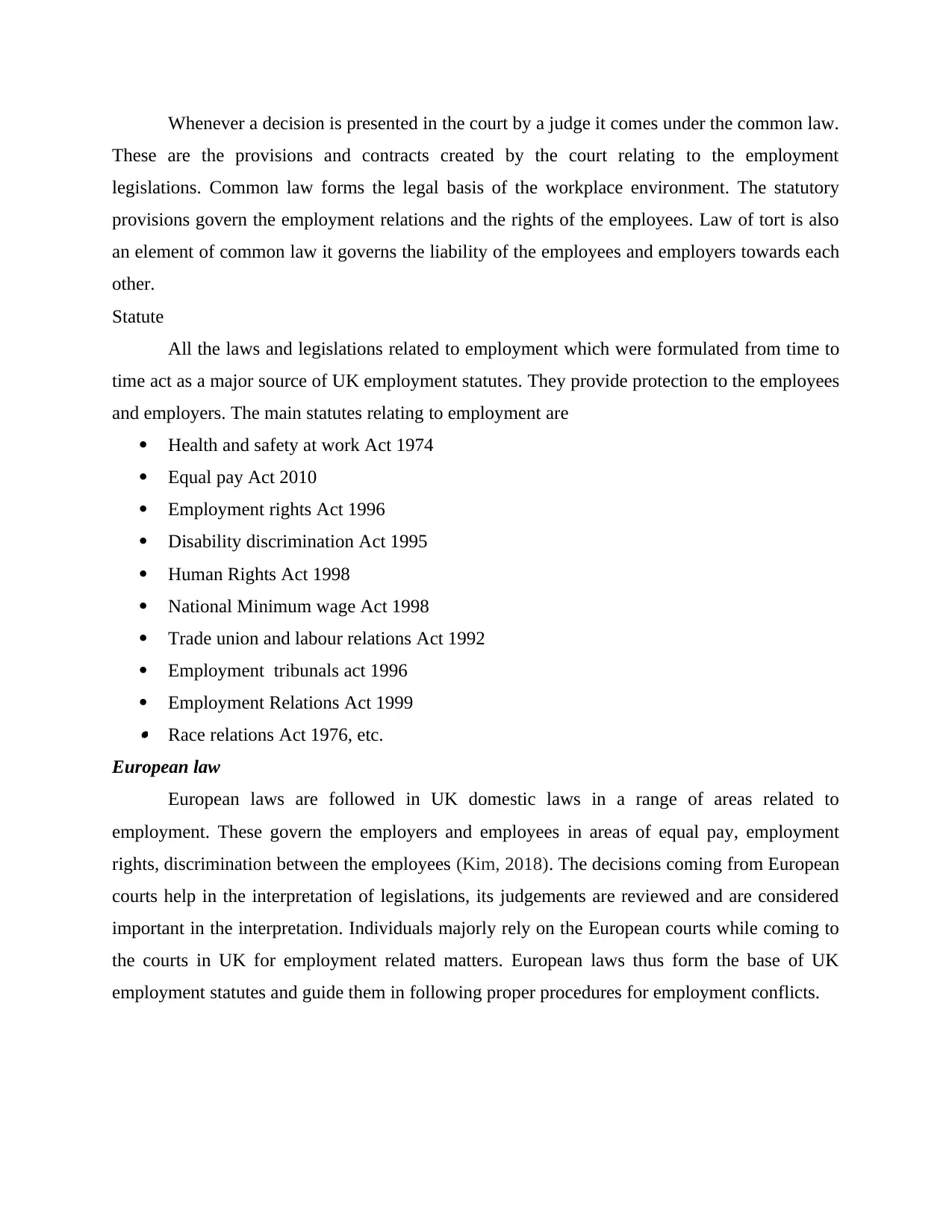
Whenever a decision is presented in the court by a judge it comes under the common law.
These are the provisions and contracts created by the court relating to the employment
legislations. Common law forms the legal basis of the workplace environment. The statutory
provisions govern the employment relations and the rights of the employees. Law of tort is also
an element of common law it governs the liability of the employees and employers towards each
other.
Statute
All the laws and legislations related to employment which were formulated from time to
time act as a major source of UK employment statutes. They provide protection to the employees
and employers. The main statutes relating to employment are
Health and safety at work Act 1974
Equal pay Act 2010
Employment rights Act 1996
Disability discrimination Act 1995
Human Rights Act 1998
National Minimum wage Act 1998
Trade union and labour relations Act 1992
Employment tribunals act 1996
Employment Relations Act 1999 Race relations Act 1976, etc.
European law
European laws are followed in UK domestic laws in a range of areas related to
employment. These govern the employers and employees in areas of equal pay, employment
rights, discrimination between the employees (Kim, 2018). The decisions coming from European
courts help in the interpretation of legislations, its judgements are reviewed and are considered
important in the interpretation. Individuals majorly rely on the European courts while coming to
the courts in UK for employment related matters. European laws thus form the base of UK
employment statutes and guide them in following proper procedures for employment conflicts.
These are the provisions and contracts created by the court relating to the employment
legislations. Common law forms the legal basis of the workplace environment. The statutory
provisions govern the employment relations and the rights of the employees. Law of tort is also
an element of common law it governs the liability of the employees and employers towards each
other.
Statute
All the laws and legislations related to employment which were formulated from time to
time act as a major source of UK employment statutes. They provide protection to the employees
and employers. The main statutes relating to employment are
Health and safety at work Act 1974
Equal pay Act 2010
Employment rights Act 1996
Disability discrimination Act 1995
Human Rights Act 1998
National Minimum wage Act 1998
Trade union and labour relations Act 1992
Employment tribunals act 1996
Employment Relations Act 1999 Race relations Act 1976, etc.
European law
European laws are followed in UK domestic laws in a range of areas related to
employment. These govern the employers and employees in areas of equal pay, employment
rights, discrimination between the employees (Kim, 2018). The decisions coming from European
courts help in the interpretation of legislations, its judgements are reviewed and are considered
important in the interpretation. Individuals majorly rely on the European courts while coming to
the courts in UK for employment related matters. European laws thus form the base of UK
employment statutes and guide them in following proper procedures for employment conflicts.
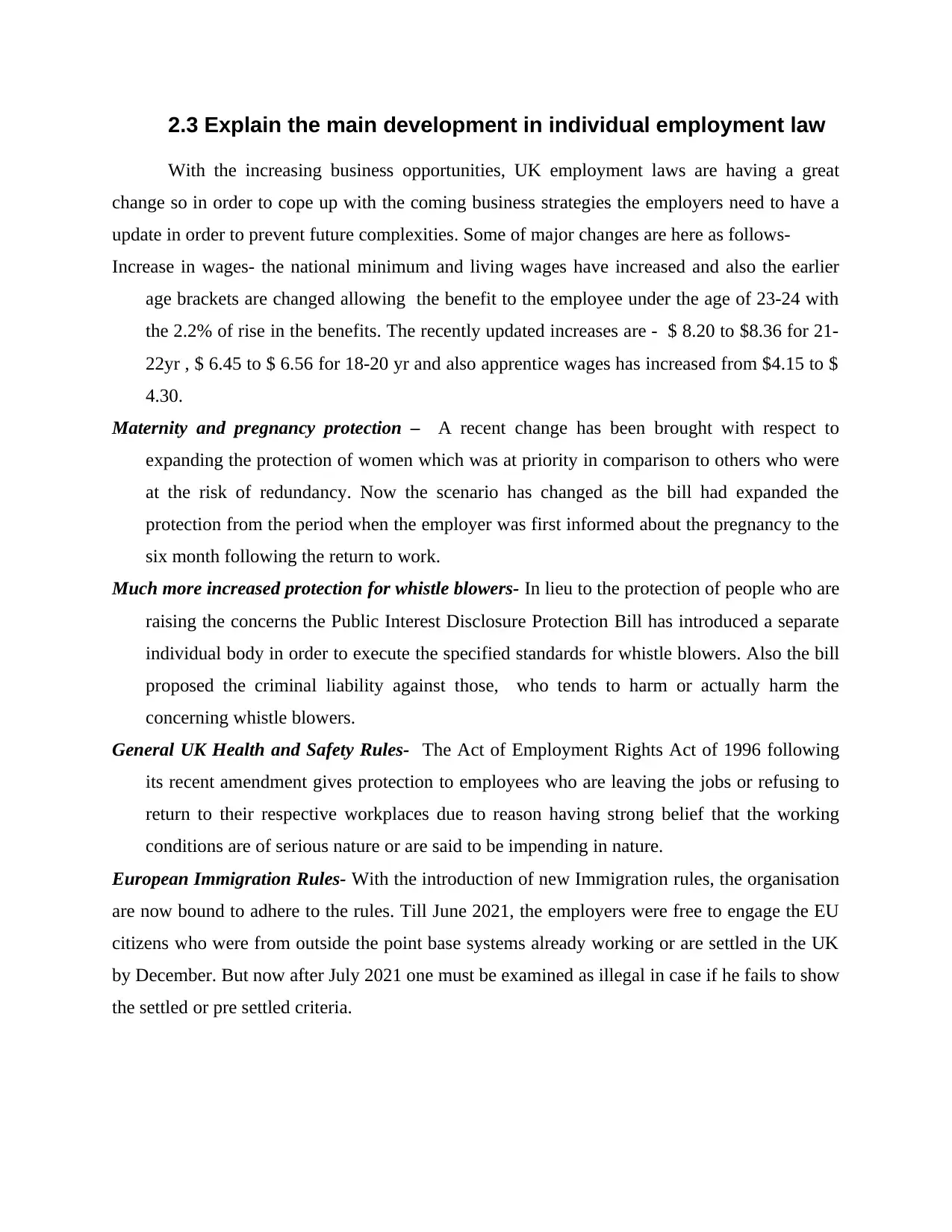
2.3 Explain the main development in individual employment law
With the increasing business opportunities, UK employment laws are having a great
change so in order to cope up with the coming business strategies the employers need to have a
update in order to prevent future complexities. Some of major changes are here as follows-
Increase in wages- the national minimum and living wages have increased and also the earlier
age brackets are changed allowing the benefit to the employee under the age of 23-24 with
the 2.2% of rise in the benefits. The recently updated increases are - $ 8.20 to $8.36 for 21-
22yr , $ 6.45 to $ 6.56 for 18-20 yr and also apprentice wages has increased from $4.15 to $
4.30.
Maternity and pregnancy protection – A recent change has been brought with respect to
expanding the protection of women which was at priority in comparison to others who were
at the risk of redundancy. Now the scenario has changed as the bill had expanded the
protection from the period when the employer was first informed about the pregnancy to the
six month following the return to work.
Much more increased protection for whistle blowers- In lieu to the protection of people who are
raising the concerns the Public Interest Disclosure Protection Bill has introduced a separate
individual body in order to execute the specified standards for whistle blowers. Also the bill
proposed the criminal liability against those, who tends to harm or actually harm the
concerning whistle blowers.
General UK Health and Safety Rules- The Act of Employment Rights Act of 1996 following
its recent amendment gives protection to employees who are leaving the jobs or refusing to
return to their respective workplaces due to reason having strong belief that the working
conditions are of serious nature or are said to be impending in nature.
European Immigration Rules- With the introduction of new Immigration rules, the organisation
are now bound to adhere to the rules. Till June 2021, the employers were free to engage the EU
citizens who were from outside the point base systems already working or are settled in the UK
by December. But now after July 2021 one must be examined as illegal in case if he fails to show
the settled or pre settled criteria.
With the increasing business opportunities, UK employment laws are having a great
change so in order to cope up with the coming business strategies the employers need to have a
update in order to prevent future complexities. Some of major changes are here as follows-
Increase in wages- the national minimum and living wages have increased and also the earlier
age brackets are changed allowing the benefit to the employee under the age of 23-24 with
the 2.2% of rise in the benefits. The recently updated increases are - $ 8.20 to $8.36 for 21-
22yr , $ 6.45 to $ 6.56 for 18-20 yr and also apprentice wages has increased from $4.15 to $
4.30.
Maternity and pregnancy protection – A recent change has been brought with respect to
expanding the protection of women which was at priority in comparison to others who were
at the risk of redundancy. Now the scenario has changed as the bill had expanded the
protection from the period when the employer was first informed about the pregnancy to the
six month following the return to work.
Much more increased protection for whistle blowers- In lieu to the protection of people who are
raising the concerns the Public Interest Disclosure Protection Bill has introduced a separate
individual body in order to execute the specified standards for whistle blowers. Also the bill
proposed the criminal liability against those, who tends to harm or actually harm the
concerning whistle blowers.
General UK Health and Safety Rules- The Act of Employment Rights Act of 1996 following
its recent amendment gives protection to employees who are leaving the jobs or refusing to
return to their respective workplaces due to reason having strong belief that the working
conditions are of serious nature or are said to be impending in nature.
European Immigration Rules- With the introduction of new Immigration rules, the organisation
are now bound to adhere to the rules. Till June 2021, the employers were free to engage the EU
citizens who were from outside the point base systems already working or are settled in the UK
by December. But now after July 2021 one must be examined as illegal in case if he fails to show
the settled or pre settled criteria.
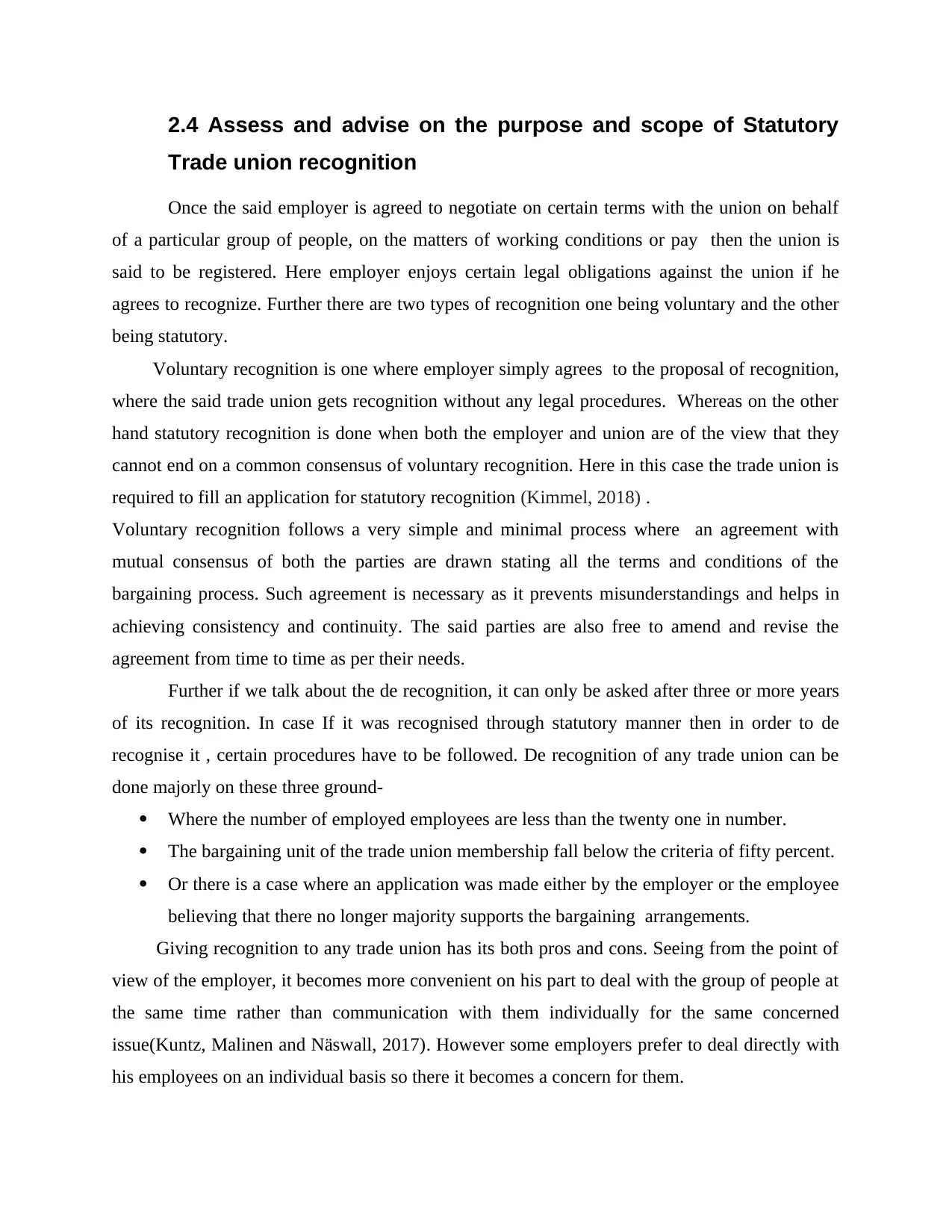
2.4 Assess and advise on the purpose and scope of Statutory
Trade union recognition
Once the said employer is agreed to negotiate on certain terms with the union on behalf
of a particular group of people, on the matters of working conditions or pay then the union is
said to be registered. Here employer enjoys certain legal obligations against the union if he
agrees to recognize. Further there are two types of recognition one being voluntary and the other
being statutory.
Voluntary recognition is one where employer simply agrees to the proposal of recognition,
where the said trade union gets recognition without any legal procedures. Whereas on the other
hand statutory recognition is done when both the employer and union are of the view that they
cannot end on a common consensus of voluntary recognition. Here in this case the trade union is
required to fill an application for statutory recognition (Kimmel, 2018) .
Voluntary recognition follows a very simple and minimal process where an agreement with
mutual consensus of both the parties are drawn stating all the terms and conditions of the
bargaining process. Such agreement is necessary as it prevents misunderstandings and helps in
achieving consistency and continuity. The said parties are also free to amend and revise the
agreement from time to time as per their needs.
Further if we talk about the de recognition, it can only be asked after three or more years
of its recognition. In case If it was recognised through statutory manner then in order to de
recognise it , certain procedures have to be followed. De recognition of any trade union can be
done majorly on these three ground-
Where the number of employed employees are less than the twenty one in number.
The bargaining unit of the trade union membership fall below the criteria of fifty percent.
Or there is a case where an application was made either by the employer or the employee
believing that there no longer majority supports the bargaining arrangements.
Giving recognition to any trade union has its both pros and cons. Seeing from the point of
view of the employer, it becomes more convenient on his part to deal with the group of people at
the same time rather than communication with them individually for the same concerned
issue(Kuntz, Malinen and Näswall, 2017). However some employers prefer to deal directly with
his employees on an individual basis so there it becomes a concern for them.
Trade union recognition
Once the said employer is agreed to negotiate on certain terms with the union on behalf
of a particular group of people, on the matters of working conditions or pay then the union is
said to be registered. Here employer enjoys certain legal obligations against the union if he
agrees to recognize. Further there are two types of recognition one being voluntary and the other
being statutory.
Voluntary recognition is one where employer simply agrees to the proposal of recognition,
where the said trade union gets recognition without any legal procedures. Whereas on the other
hand statutory recognition is done when both the employer and union are of the view that they
cannot end on a common consensus of voluntary recognition. Here in this case the trade union is
required to fill an application for statutory recognition (Kimmel, 2018) .
Voluntary recognition follows a very simple and minimal process where an agreement with
mutual consensus of both the parties are drawn stating all the terms and conditions of the
bargaining process. Such agreement is necessary as it prevents misunderstandings and helps in
achieving consistency and continuity. The said parties are also free to amend and revise the
agreement from time to time as per their needs.
Further if we talk about the de recognition, it can only be asked after three or more years
of its recognition. In case If it was recognised through statutory manner then in order to de
recognise it , certain procedures have to be followed. De recognition of any trade union can be
done majorly on these three ground-
Where the number of employed employees are less than the twenty one in number.
The bargaining unit of the trade union membership fall below the criteria of fifty percent.
Or there is a case where an application was made either by the employer or the employee
believing that there no longer majority supports the bargaining arrangements.
Giving recognition to any trade union has its both pros and cons. Seeing from the point of
view of the employer, it becomes more convenient on his part to deal with the group of people at
the same time rather than communication with them individually for the same concerned
issue(Kuntz, Malinen and Näswall, 2017). However some employers prefer to deal directly with
his employees on an individual basis so there it becomes a concern for them.
Paraphrase This Document
Need a fresh take? Get an instant paraphrase of this document with our AI Paraphraser
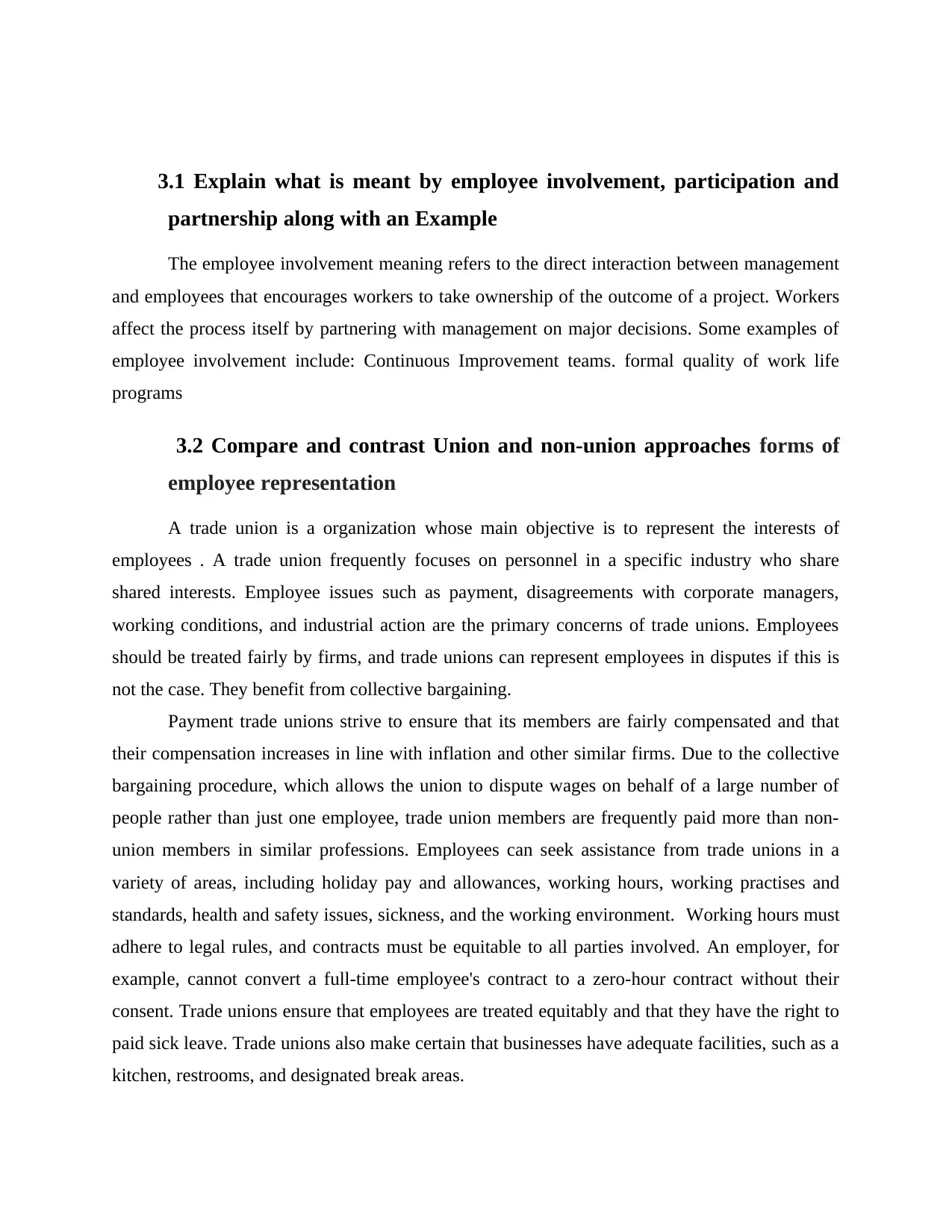
3.1 Explain what is meant by employee involvement, participation and
partnership along with an Example
The employee involvement meaning refers to the direct interaction between management
and employees that encourages workers to take ownership of the outcome of a project. Workers
affect the process itself by partnering with management on major decisions. Some examples of
employee involvement include: Continuous Improvement teams. formal quality of work life
programs
3.2 Compare and contrast Union and non-union approaches forms of
employee representation
A trade union is a organization whose main objective is to represent the interests of
employees . A trade union frequently focuses on personnel in a specific industry who share
shared interests. Employee issues such as payment, disagreements with corporate managers,
working conditions, and industrial action are the primary concerns of trade unions. Employees
should be treated fairly by firms, and trade unions can represent employees in disputes if this is
not the case. They benefit from collective bargaining.
Payment trade unions strive to ensure that its members are fairly compensated and that
their compensation increases in line with inflation and other similar firms. Due to the collective
bargaining procedure, which allows the union to dispute wages on behalf of a large number of
people rather than just one employee, trade union members are frequently paid more than non-
union members in similar professions. Employees can seek assistance from trade unions in a
variety of areas, including holiday pay and allowances, working hours, working practises and
standards, health and safety issues, sickness, and the working environment. Working hours must
adhere to legal rules, and contracts must be equitable to all parties involved. An employer, for
example, cannot convert a full-time employee's contract to a zero-hour contract without their
consent. Trade unions ensure that employees are treated equitably and that they have the right to
paid sick leave. Trade unions also make certain that businesses have adequate facilities, such as a
kitchen, restrooms, and designated break areas.
partnership along with an Example
The employee involvement meaning refers to the direct interaction between management
and employees that encourages workers to take ownership of the outcome of a project. Workers
affect the process itself by partnering with management on major decisions. Some examples of
employee involvement include: Continuous Improvement teams. formal quality of work life
programs
3.2 Compare and contrast Union and non-union approaches forms of
employee representation
A trade union is a organization whose main objective is to represent the interests of
employees . A trade union frequently focuses on personnel in a specific industry who share
shared interests. Employee issues such as payment, disagreements with corporate managers,
working conditions, and industrial action are the primary concerns of trade unions. Employees
should be treated fairly by firms, and trade unions can represent employees in disputes if this is
not the case. They benefit from collective bargaining.
Payment trade unions strive to ensure that its members are fairly compensated and that
their compensation increases in line with inflation and other similar firms. Due to the collective
bargaining procedure, which allows the union to dispute wages on behalf of a large number of
people rather than just one employee, trade union members are frequently paid more than non-
union members in similar professions. Employees can seek assistance from trade unions in a
variety of areas, including holiday pay and allowances, working hours, working practises and
standards, health and safety issues, sickness, and the working environment. Working hours must
adhere to legal rules, and contracts must be equitable to all parties involved. An employer, for
example, cannot convert a full-time employee's contract to a zero-hour contract without their
consent. Trade unions ensure that employees are treated equitably and that they have the right to
paid sick leave. Trade unions also make certain that businesses have adequate facilities, such as a
kitchen, restrooms, and designated break areas.

When an employer refuses to cooperate with a trade union's or group of employees'
requests, and negotiations fail to settle the matter, a trade union may turn to industrial action.
Strikes and go-slows are examples of industrial action (Shearing, 2018). Employers are
frequently persuaded to negotiate and make changes by the fear of industrial action. If no
changes are achieved as a result of the strike, it is frequently repeated until negotiations and
modifications are reached.
When a workforce refuses to work, services or production are often forced to halt
completely if a replacement labour cannot be obtained. A trade union must complete a ballot and
a strike must be approved by a majority of its members in order to go on strike. Employees on
strike have two options: they can either leave the workplace or form a picket line outside their
workplace.
Non Union approach
1. Unions do not offer free representation.
It is not possible to join a union without paying a fee.Union dues can cost anywhere from
$200 to several hundred dollars each year, which can eat up a significant portion of a worker's
paycheck - if they can afford to pay them (not all unionised workers are compelled to pay. As a
result, workers pay a portion of their wages to enjoy the advantages of union representation,
which can be as high as 2.5 percent in some cases.
2. Workers and employers may be pitted against each other through unions.
Some may claim that unions place employees against corporations, always fighting for
their rights rather than cooperating with corporations to achieve a common purpose. this might
have a negative impact on a company's culture.
3. Union decisions may not necessarily reflect the desires of individual workers.
Many unions are politically active, and as a result, they will lobby governments on a
local, state, and national level. Of course, not all union members will hold the same political
beliefs. This can create some friction, especially when lobbying activities are frequently funded
by the dues that workers pay to join a union.
requests, and negotiations fail to settle the matter, a trade union may turn to industrial action.
Strikes and go-slows are examples of industrial action (Shearing, 2018). Employers are
frequently persuaded to negotiate and make changes by the fear of industrial action. If no
changes are achieved as a result of the strike, it is frequently repeated until negotiations and
modifications are reached.
When a workforce refuses to work, services or production are often forced to halt
completely if a replacement labour cannot be obtained. A trade union must complete a ballot and
a strike must be approved by a majority of its members in order to go on strike. Employees on
strike have two options: they can either leave the workplace or form a picket line outside their
workplace.
Non Union approach
1. Unions do not offer free representation.
It is not possible to join a union without paying a fee.Union dues can cost anywhere from
$200 to several hundred dollars each year, which can eat up a significant portion of a worker's
paycheck - if they can afford to pay them (not all unionised workers are compelled to pay. As a
result, workers pay a portion of their wages to enjoy the advantages of union representation,
which can be as high as 2.5 percent in some cases.
2. Workers and employers may be pitted against each other through unions.
Some may claim that unions place employees against corporations, always fighting for
their rights rather than cooperating with corporations to achieve a common purpose. this might
have a negative impact on a company's culture.
3. Union decisions may not necessarily reflect the desires of individual workers.
Many unions are politically active, and as a result, they will lobby governments on a
local, state, and national level. Of course, not all union members will hold the same political
beliefs. This can create some friction, especially when lobbying activities are frequently funded
by the dues that workers pay to join a union.
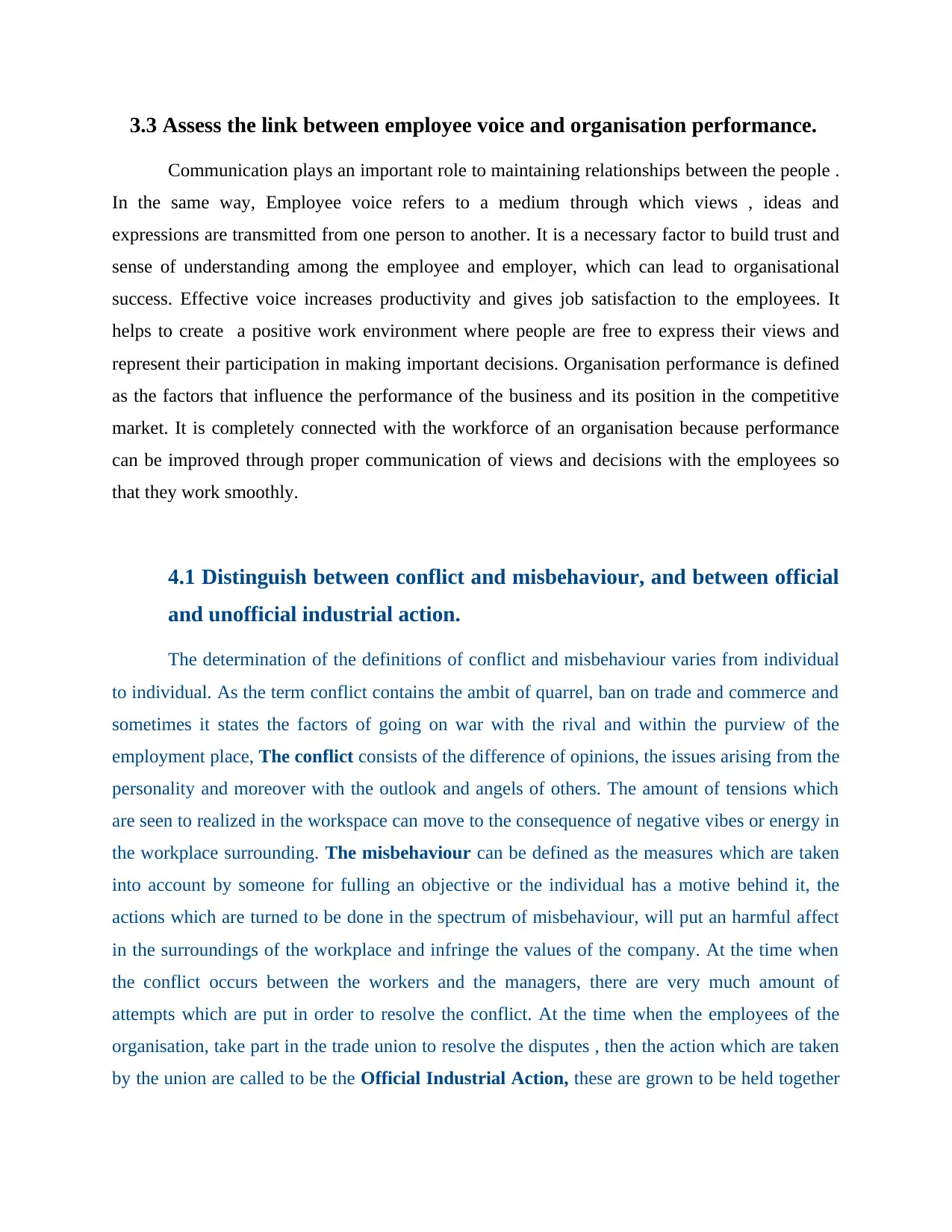
3.3 Assess the link between employee voice and organisation performance.
Communication plays an important role to maintaining relationships between the people .
In the same way, Employee voice refers to a medium through which views , ideas and
expressions are transmitted from one person to another. It is a necessary factor to build trust and
sense of understanding among the employee and employer, which can lead to organisational
success. Effective voice increases productivity and gives job satisfaction to the employees. It
helps to create a positive work environment where people are free to express their views and
represent their participation in making important decisions. Organisation performance is defined
as the factors that influence the performance of the business and its position in the competitive
market. It is completely connected with the workforce of an organisation because performance
can be improved through proper communication of views and decisions with the employees so
that they work smoothly.
4.1 Distinguish between conflict and misbehaviour, and between official
and unofficial industrial action.
The determination of the definitions of conflict and misbehaviour varies from individual
to individual. As the term conflict contains the ambit of quarrel, ban on trade and commerce and
sometimes it states the factors of going on war with the rival and within the purview of the
employment place, The conflict consists of the difference of opinions, the issues arising from the
personality and moreover with the outlook and angels of others. The amount of tensions which
are seen to realized in the workspace can move to the consequence of negative vibes or energy in
the workplace surrounding. The misbehaviour can be defined as the measures which are taken
into account by someone for fulling an objective or the individual has a motive behind it, the
actions which are turned to be done in the spectrum of misbehaviour, will put an harmful affect
in the surroundings of the workplace and infringe the values of the company. At the time when
the conflict occurs between the workers and the managers, there are very much amount of
attempts which are put in order to resolve the conflict. At the time when the employees of the
organisation, take part in the trade union to resolve the disputes , then the action which are taken
by the union are called to be the Official Industrial Action, these are grown to be held together
Communication plays an important role to maintaining relationships between the people .
In the same way, Employee voice refers to a medium through which views , ideas and
expressions are transmitted from one person to another. It is a necessary factor to build trust and
sense of understanding among the employee and employer, which can lead to organisational
success. Effective voice increases productivity and gives job satisfaction to the employees. It
helps to create a positive work environment where people are free to express their views and
represent their participation in making important decisions. Organisation performance is defined
as the factors that influence the performance of the business and its position in the competitive
market. It is completely connected with the workforce of an organisation because performance
can be improved through proper communication of views and decisions with the employees so
that they work smoothly.
4.1 Distinguish between conflict and misbehaviour, and between official
and unofficial industrial action.
The determination of the definitions of conflict and misbehaviour varies from individual
to individual. As the term conflict contains the ambit of quarrel, ban on trade and commerce and
sometimes it states the factors of going on war with the rival and within the purview of the
employment place, The conflict consists of the difference of opinions, the issues arising from the
personality and moreover with the outlook and angels of others. The amount of tensions which
are seen to realized in the workspace can move to the consequence of negative vibes or energy in
the workplace surrounding. The misbehaviour can be defined as the measures which are taken
into account by someone for fulling an objective or the individual has a motive behind it, the
actions which are turned to be done in the spectrum of misbehaviour, will put an harmful affect
in the surroundings of the workplace and infringe the values of the company. At the time when
the conflict occurs between the workers and the managers, there are very much amount of
attempts which are put in order to resolve the conflict. At the time when the employees of the
organisation, take part in the trade union to resolve the disputes , then the action which are taken
by the union are called to be the Official Industrial Action, these are grown to be held together
Secure Best Marks with AI Grader
Need help grading? Try our AI Grader for instant feedback on your assignments.

by the legal obligations The trade union safeguard the rights of the employees. In the time being
when the employees action or the dispute resolution is not includes in the scope of any trade
union, then the action which are taken will be called out to be as , Unofficial Industrial Actions,
these actions does not give rise to any legal obligatory (Abdul-Malak,and Senan, 2020.).
4.2 Assess contemporary trends in the type of conflict and industrial
sanctions.
The organisation which tends to have the conflicts mainly because of the reasons that the
workers leads happen to have a difference of opinions or contradictory perspective on the ideas
share in the organisation. Non-identical demeanour in the workspace can have indefinite
disputes between each other. The corporation which e,bodies of the manager which plays a
crucial role as an authority to resolve the conflict on the workspaces. The pessimistic measures
which turn out be encountered in the mean time of conflict,which incudes the decreasing the
productivity and constructive manners of the employees, dismissals of the workers, declaration
of thinking , discrimination and communication issues. In the time being when the relations of
employees and the employers are ruptured badly, cannot be fixed using any measurement,the it
gives rise to the Industrial Sanction, the bondage breakage to be severe to be resolved with any
actions. By these conflict and disputes the situations and circumstance of the working
atmosphere is unable to solidify to recover to present peace state. In the state of affairs of the
conflict the head or the authority members of the company, can bring about actions in order to
punish the individual who created the chaos and diminish the work environment.
4.3 Explain what is required to advice, coach and guide, line managers
in the skills for effective grievance and disputes handling procedures.
The responsibilities which arises in everyday life of a Line Managers, which tends to
look after the actions and activities which takes place within the purview of workplace. The
designation of line managers which takes place and try their level best to resolve the conflicts
inside the work environment , without any confits the workspace open to new opportunities and
employees and the employers grows to work with each other peacefully. The obligations and
when the employees action or the dispute resolution is not includes in the scope of any trade
union, then the action which are taken will be called out to be as , Unofficial Industrial Actions,
these actions does not give rise to any legal obligatory (Abdul-Malak,and Senan, 2020.).
4.2 Assess contemporary trends in the type of conflict and industrial
sanctions.
The organisation which tends to have the conflicts mainly because of the reasons that the
workers leads happen to have a difference of opinions or contradictory perspective on the ideas
share in the organisation. Non-identical demeanour in the workspace can have indefinite
disputes between each other. The corporation which e,bodies of the manager which plays a
crucial role as an authority to resolve the conflict on the workspaces. The pessimistic measures
which turn out be encountered in the mean time of conflict,which incudes the decreasing the
productivity and constructive manners of the employees, dismissals of the workers, declaration
of thinking , discrimination and communication issues. In the time being when the relations of
employees and the employers are ruptured badly, cannot be fixed using any measurement,the it
gives rise to the Industrial Sanction, the bondage breakage to be severe to be resolved with any
actions. By these conflict and disputes the situations and circumstance of the working
atmosphere is unable to solidify to recover to present peace state. In the state of affairs of the
conflict the head or the authority members of the company, can bring about actions in order to
punish the individual who created the chaos and diminish the work environment.
4.3 Explain what is required to advice, coach and guide, line managers
in the skills for effective grievance and disputes handling procedures.
The responsibilities which arises in everyday life of a Line Managers, which tends to
look after the actions and activities which takes place within the purview of workplace. The
designation of line managers which takes place and try their level best to resolve the conflicts
inside the work environment , without any confits the workspace open to new opportunities and
employees and the employers grows to work with each other peacefully. The obligations and
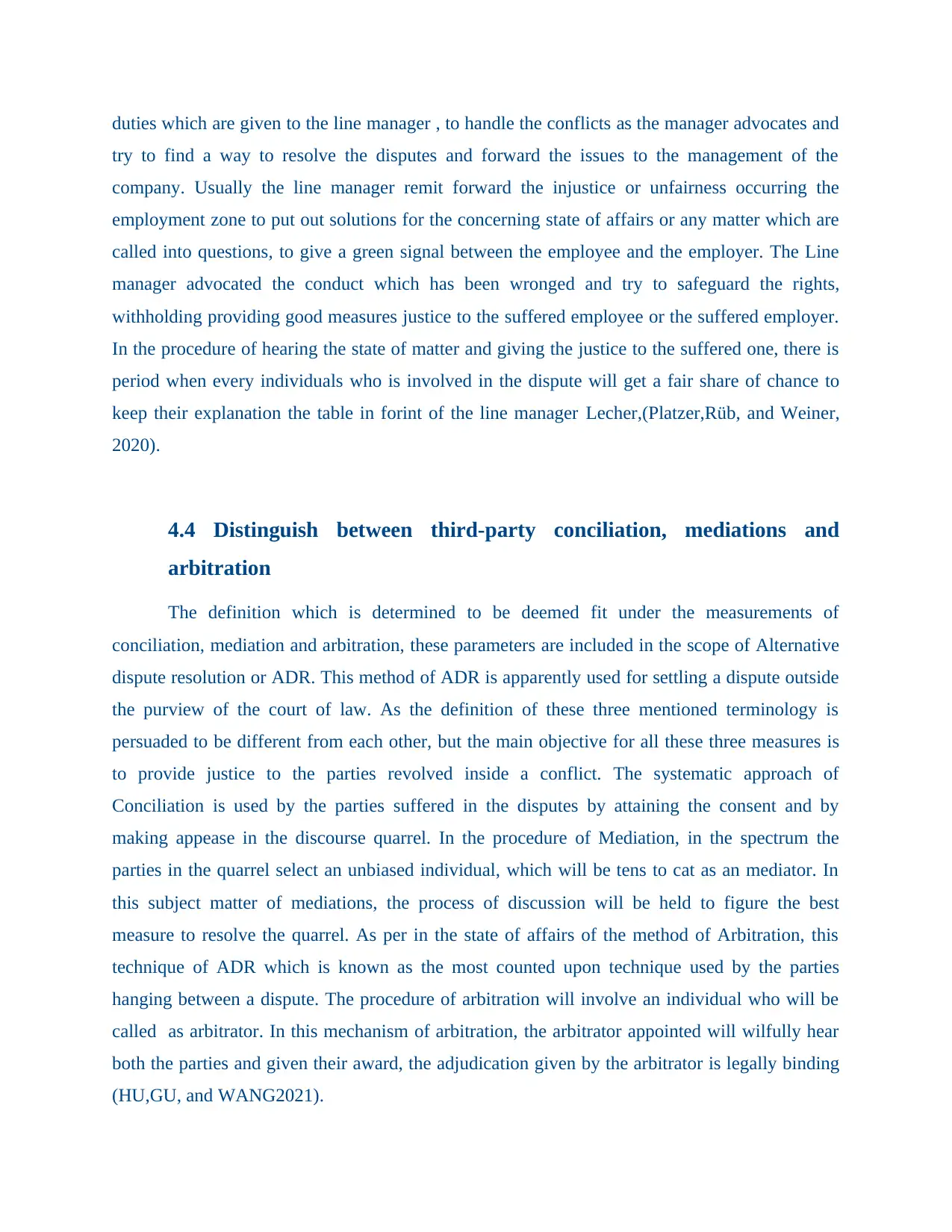
duties which are given to the line manager , to handle the conflicts as the manager advocates and
try to find a way to resolve the disputes and forward the issues to the management of the
company. Usually the line manager remit forward the injustice or unfairness occurring the
employment zone to put out solutions for the concerning state of affairs or any matter which are
called into questions, to give a green signal between the employee and the employer. The Line
manager advocated the conduct which has been wronged and try to safeguard the rights,
withholding providing good measures justice to the suffered employee or the suffered employer.
In the procedure of hearing the state of matter and giving the justice to the suffered one, there is
period when every individuals who is involved in the dispute will get a fair share of chance to
keep their explanation the table in forint of the line manager Lecher,(Platzer,Rüb, and Weiner,
2020).
4.4 Distinguish between third-party conciliation, mediations and
arbitration
The definition which is determined to be deemed fit under the measurements of
conciliation, mediation and arbitration, these parameters are included in the scope of Alternative
dispute resolution or ADR. This method of ADR is apparently used for settling a dispute outside
the purview of the court of law. As the definition of these three mentioned terminology is
persuaded to be different from each other, but the main objective for all these three measures is
to provide justice to the parties revolved inside a conflict. The systematic approach of
Conciliation is used by the parties suffered in the disputes by attaining the consent and by
making appease in the discourse quarrel. In the procedure of Mediation, in the spectrum the
parties in the quarrel select an unbiased individual, which will be tens to cat as an mediator. In
this subject matter of mediations, the process of discussion will be held to figure the best
measure to resolve the quarrel. As per in the state of affairs of the method of Arbitration, this
technique of ADR which is known as the most counted upon technique used by the parties
hanging between a dispute. The procedure of arbitration will involve an individual who will be
called as arbitrator. In this mechanism of arbitration, the arbitrator appointed will wilfully hear
both the parties and given their award, the adjudication given by the arbitrator is legally binding
(HU,GU, and WANG2021).
try to find a way to resolve the disputes and forward the issues to the management of the
company. Usually the line manager remit forward the injustice or unfairness occurring the
employment zone to put out solutions for the concerning state of affairs or any matter which are
called into questions, to give a green signal between the employee and the employer. The Line
manager advocated the conduct which has been wronged and try to safeguard the rights,
withholding providing good measures justice to the suffered employee or the suffered employer.
In the procedure of hearing the state of matter and giving the justice to the suffered one, there is
period when every individuals who is involved in the dispute will get a fair share of chance to
keep their explanation the table in forint of the line manager Lecher,(Platzer,Rüb, and Weiner,
2020).
4.4 Distinguish between third-party conciliation, mediations and
arbitration
The definition which is determined to be deemed fit under the measurements of
conciliation, mediation and arbitration, these parameters are included in the scope of Alternative
dispute resolution or ADR. This method of ADR is apparently used for settling a dispute outside
the purview of the court of law. As the definition of these three mentioned terminology is
persuaded to be different from each other, but the main objective for all these three measures is
to provide justice to the parties revolved inside a conflict. The systematic approach of
Conciliation is used by the parties suffered in the disputes by attaining the consent and by
making appease in the discourse quarrel. In the procedure of Mediation, in the spectrum the
parties in the quarrel select an unbiased individual, which will be tens to cat as an mediator. In
this subject matter of mediations, the process of discussion will be held to figure the best
measure to resolve the quarrel. As per in the state of affairs of the method of Arbitration, this
technique of ADR which is known as the most counted upon technique used by the parties
hanging between a dispute. The procedure of arbitration will involve an individual who will be
called as arbitrator. In this mechanism of arbitration, the arbitrator appointed will wilfully hear
both the parties and given their award, the adjudication given by the arbitrator is legally binding
(HU,GU, and WANG2021).
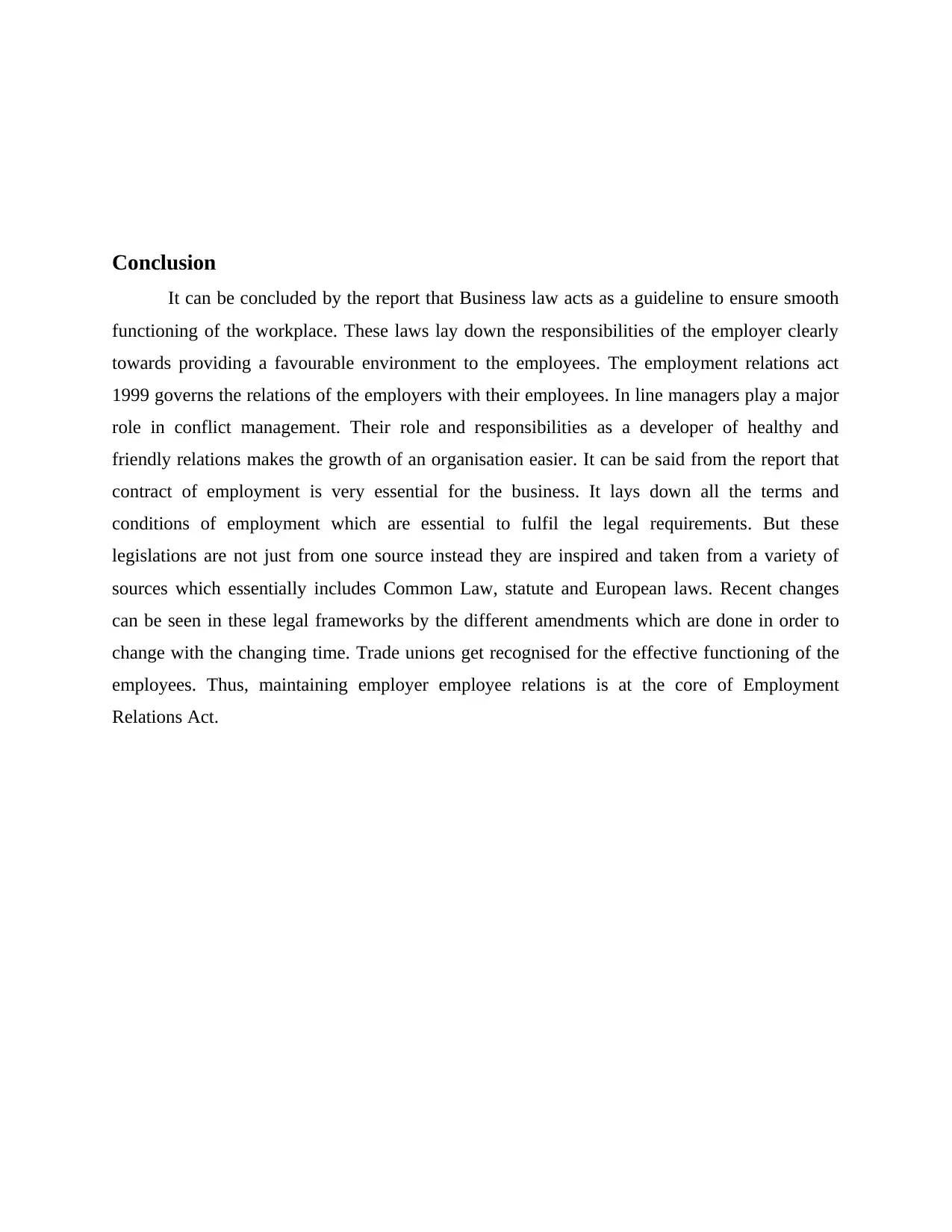
Conclusion
It can be concluded by the report that Business law acts as a guideline to ensure smooth
functioning of the workplace. These laws lay down the responsibilities of the employer clearly
towards providing a favourable environment to the employees. The employment relations act
1999 governs the relations of the employers with their employees. In line managers play a major
role in conflict management. Their role and responsibilities as a developer of healthy and
friendly relations makes the growth of an organisation easier. It can be said from the report that
contract of employment is very essential for the business. It lays down all the terms and
conditions of employment which are essential to fulfil the legal requirements. But these
legislations are not just from one source instead they are inspired and taken from a variety of
sources which essentially includes Common Law, statute and European laws. Recent changes
can be seen in these legal frameworks by the different amendments which are done in order to
change with the changing time. Trade unions get recognised for the effective functioning of the
employees. Thus, maintaining employer employee relations is at the core of Employment
Relations Act.
It can be concluded by the report that Business law acts as a guideline to ensure smooth
functioning of the workplace. These laws lay down the responsibilities of the employer clearly
towards providing a favourable environment to the employees. The employment relations act
1999 governs the relations of the employers with their employees. In line managers play a major
role in conflict management. Their role and responsibilities as a developer of healthy and
friendly relations makes the growth of an organisation easier. It can be said from the report that
contract of employment is very essential for the business. It lays down all the terms and
conditions of employment which are essential to fulfil the legal requirements. But these
legislations are not just from one source instead they are inspired and taken from a variety of
sources which essentially includes Common Law, statute and European laws. Recent changes
can be seen in these legal frameworks by the different amendments which are done in order to
change with the changing time. Trade unions get recognised for the effective functioning of the
employees. Thus, maintaining employer employee relations is at the core of Employment
Relations Act.
Paraphrase This Document
Need a fresh take? Get an instant paraphrase of this document with our AI Paraphraser
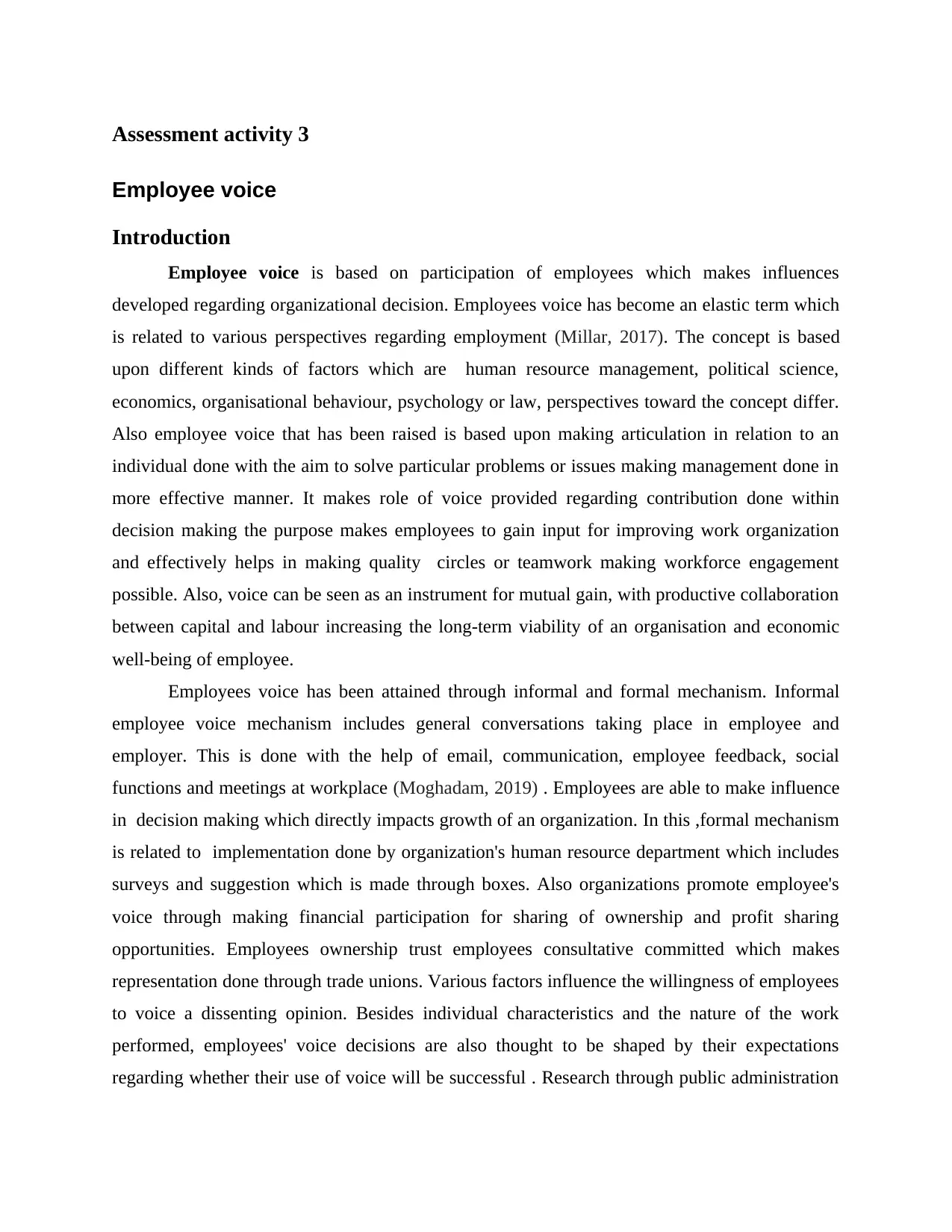
Assessment activity 3
Employee voice
Introduction
Employee voice is based on participation of employees which makes influences
developed regarding organizational decision. Employees voice has become an elastic term which
is related to various perspectives regarding employment (Millar, 2017). The concept is based
upon different kinds of factors which are human resource management, political science,
economics, organisational behaviour, psychology or law, perspectives toward the concept differ.
Also employee voice that has been raised is based upon making articulation in relation to an
individual done with the aim to solve particular problems or issues making management done in
more effective manner. It makes role of voice provided regarding contribution done within
decision making the purpose makes employees to gain input for improving work organization
and effectively helps in making quality circles or teamwork making workforce engagement
possible. Also, voice can be seen as an instrument for mutual gain, with productive collaboration
between capital and labour increasing the long-term viability of an organisation and economic
well-being of employee.
Employees voice has been attained through informal and formal mechanism. Informal
employee voice mechanism includes general conversations taking place in employee and
employer. This is done with the help of email, communication, employee feedback, social
functions and meetings at workplace (Moghadam, 2019) . Employees are able to make influence
in decision making which directly impacts growth of an organization. In this ,formal mechanism
is related to implementation done by organization's human resource department which includes
surveys and suggestion which is made through boxes. Also organizations promote employee's
voice through making financial participation for sharing of ownership and profit sharing
opportunities. Employees ownership trust employees consultative committed which makes
representation done through trade unions. Various factors influence the willingness of employees
to voice a dissenting opinion. Besides individual characteristics and the nature of the work
performed, employees' voice decisions are also thought to be shaped by their expectations
regarding whether their use of voice will be successful . Research through public administration
Employee voice
Introduction
Employee voice is based on participation of employees which makes influences
developed regarding organizational decision. Employees voice has become an elastic term which
is related to various perspectives regarding employment (Millar, 2017). The concept is based
upon different kinds of factors which are human resource management, political science,
economics, organisational behaviour, psychology or law, perspectives toward the concept differ.
Also employee voice that has been raised is based upon making articulation in relation to an
individual done with the aim to solve particular problems or issues making management done in
more effective manner. It makes role of voice provided regarding contribution done within
decision making the purpose makes employees to gain input for improving work organization
and effectively helps in making quality circles or teamwork making workforce engagement
possible. Also, voice can be seen as an instrument for mutual gain, with productive collaboration
between capital and labour increasing the long-term viability of an organisation and economic
well-being of employee.
Employees voice has been attained through informal and formal mechanism. Informal
employee voice mechanism includes general conversations taking place in employee and
employer. This is done with the help of email, communication, employee feedback, social
functions and meetings at workplace (Moghadam, 2019) . Employees are able to make influence
in decision making which directly impacts growth of an organization. In this ,formal mechanism
is related to implementation done by organization's human resource department which includes
surveys and suggestion which is made through boxes. Also organizations promote employee's
voice through making financial participation for sharing of ownership and profit sharing
opportunities. Employees ownership trust employees consultative committed which makes
representation done through trade unions. Various factors influence the willingness of employees
to voice a dissenting opinion. Besides individual characteristics and the nature of the work
performed, employees' voice decisions are also thought to be shaped by their expectations
regarding whether their use of voice will be successful . Research through public administration
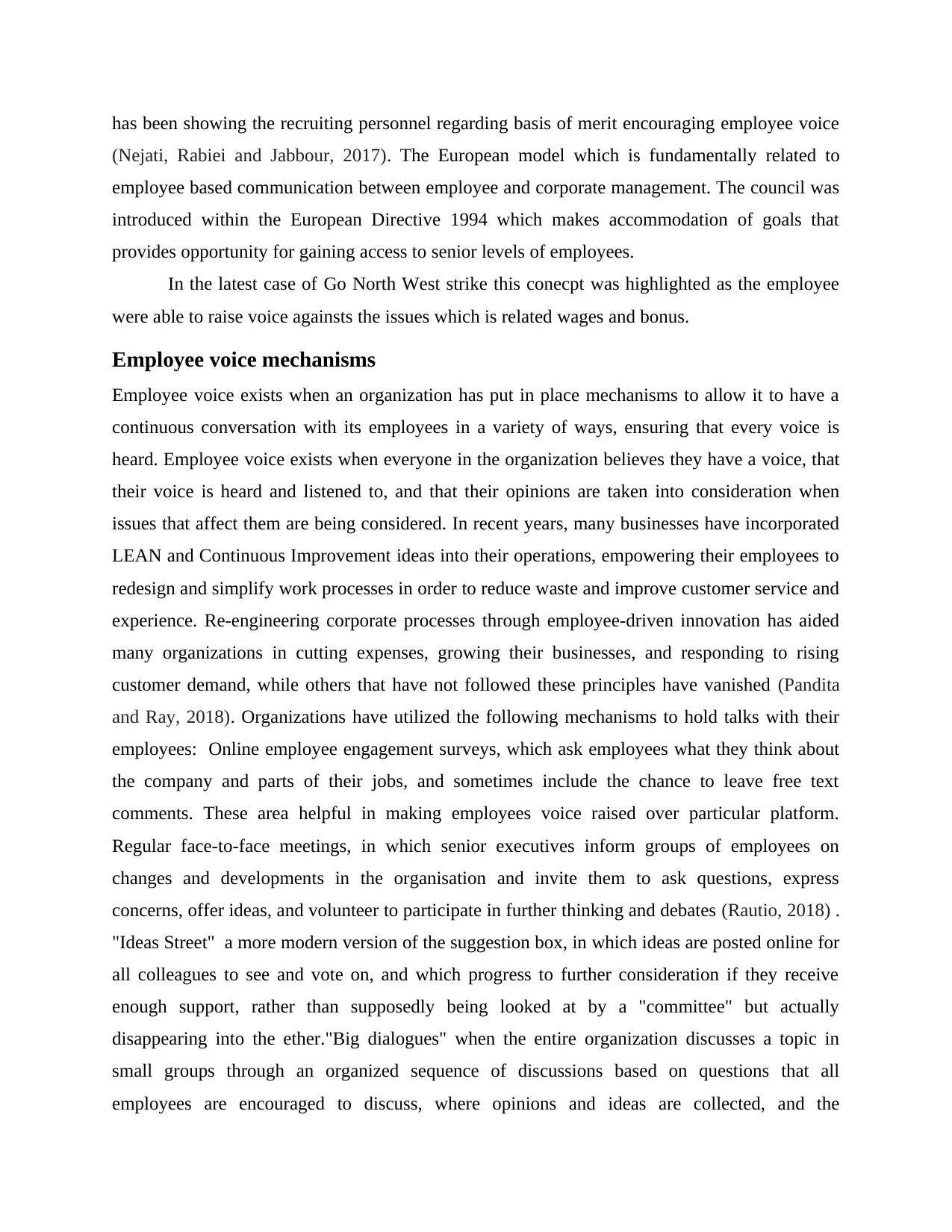
has been showing the recruiting personnel regarding basis of merit encouraging employee voice
(Nejati, Rabiei and Jabbour, 2017). The European model which is fundamentally related to
employee based communication between employee and corporate management. The council was
introduced within the European Directive 1994 which makes accommodation of goals that
provides opportunity for gaining access to senior levels of employees.
In the latest case of Go North West strike this conecpt was highlighted as the employee
were able to raise voice againsts the issues which is related wages and bonus.
Employee voice mechanisms
Employee voice exists when an organization has put in place mechanisms to allow it to have a
continuous conversation with its employees in a variety of ways, ensuring that every voice is
heard. Employee voice exists when everyone in the organization believes they have a voice, that
their voice is heard and listened to, and that their opinions are taken into consideration when
issues that affect them are being considered. In recent years, many businesses have incorporated
LEAN and Continuous Improvement ideas into their operations, empowering their employees to
redesign and simplify work processes in order to reduce waste and improve customer service and
experience. Re-engineering corporate processes through employee-driven innovation has aided
many organizations in cutting expenses, growing their businesses, and responding to rising
customer demand, while others that have not followed these principles have vanished (Pandita
and Ray, 2018). Organizations have utilized the following mechanisms to hold talks with their
employees: Online employee engagement surveys, which ask employees what they think about
the company and parts of their jobs, and sometimes include the chance to leave free text
comments. These area helpful in making employees voice raised over particular platform.
Regular face-to-face meetings, in which senior executives inform groups of employees on
changes and developments in the organisation and invite them to ask questions, express
concerns, offer ideas, and volunteer to participate in further thinking and debates (Rautio, 2018) .
"Ideas Street" a more modern version of the suggestion box, in which ideas are posted online for
all colleagues to see and vote on, and which progress to further consideration if they receive
enough support, rather than supposedly being looked at by a "committee" but actually
disappearing into the ether."Big dialogues" when the entire organization discusses a topic in
small groups through an organized sequence of discussions based on questions that all
employees are encouraged to discuss, where opinions and ideas are collected, and the
(Nejati, Rabiei and Jabbour, 2017). The European model which is fundamentally related to
employee based communication between employee and corporate management. The council was
introduced within the European Directive 1994 which makes accommodation of goals that
provides opportunity for gaining access to senior levels of employees.
In the latest case of Go North West strike this conecpt was highlighted as the employee
were able to raise voice againsts the issues which is related wages and bonus.
Employee voice mechanisms
Employee voice exists when an organization has put in place mechanisms to allow it to have a
continuous conversation with its employees in a variety of ways, ensuring that every voice is
heard. Employee voice exists when everyone in the organization believes they have a voice, that
their voice is heard and listened to, and that their opinions are taken into consideration when
issues that affect them are being considered. In recent years, many businesses have incorporated
LEAN and Continuous Improvement ideas into their operations, empowering their employees to
redesign and simplify work processes in order to reduce waste and improve customer service and
experience. Re-engineering corporate processes through employee-driven innovation has aided
many organizations in cutting expenses, growing their businesses, and responding to rising
customer demand, while others that have not followed these principles have vanished (Pandita
and Ray, 2018). Organizations have utilized the following mechanisms to hold talks with their
employees: Online employee engagement surveys, which ask employees what they think about
the company and parts of their jobs, and sometimes include the chance to leave free text
comments. These area helpful in making employees voice raised over particular platform.
Regular face-to-face meetings, in which senior executives inform groups of employees on
changes and developments in the organisation and invite them to ask questions, express
concerns, offer ideas, and volunteer to participate in further thinking and debates (Rautio, 2018) .
"Ideas Street" a more modern version of the suggestion box, in which ideas are posted online for
all colleagues to see and vote on, and which progress to further consideration if they receive
enough support, rather than supposedly being looked at by a "committee" but actually
disappearing into the ether."Big dialogues" when the entire organization discusses a topic in
small groups through an organized sequence of discussions based on questions that all
employees are encouraged to discuss, where opinions and ideas are collected, and the
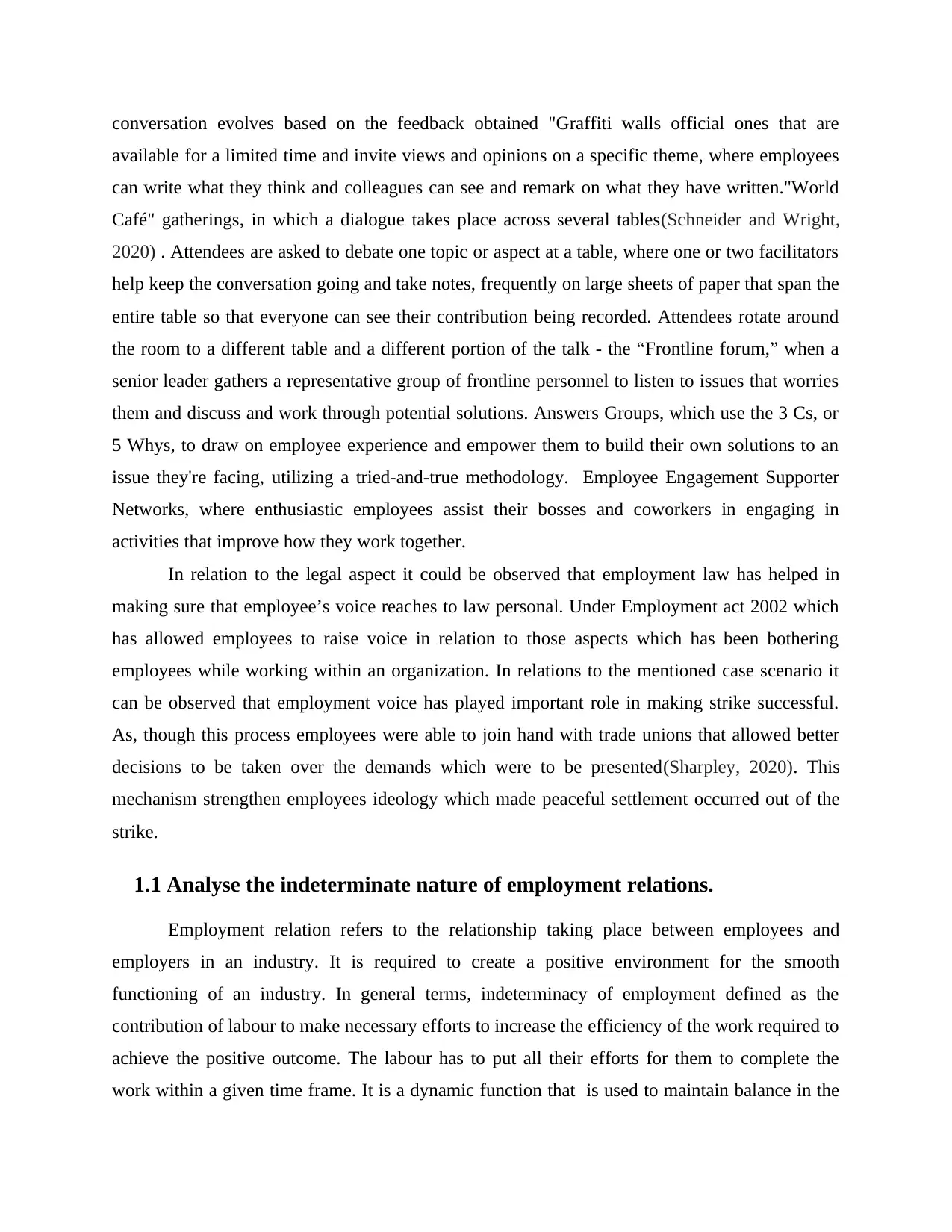
conversation evolves based on the feedback obtained "Graffiti walls official ones that are
available for a limited time and invite views and opinions on a specific theme, where employees
can write what they think and colleagues can see and remark on what they have written."World
Café" gatherings, in which a dialogue takes place across several tables(Schneider and Wright,
2020) . Attendees are asked to debate one topic or aspect at a table, where one or two facilitators
help keep the conversation going and take notes, frequently on large sheets of paper that span the
entire table so that everyone can see their contribution being recorded. Attendees rotate around
the room to a different table and a different portion of the talk - the “Frontline forum,” when a
senior leader gathers a representative group of frontline personnel to listen to issues that worries
them and discuss and work through potential solutions. Answers Groups, which use the 3 Cs, or
5 Whys, to draw on employee experience and empower them to build their own solutions to an
issue they're facing, utilizing a tried-and-true methodology. Employee Engagement Supporter
Networks, where enthusiastic employees assist their bosses and coworkers in engaging in
activities that improve how they work together.
In relation to the legal aspect it could be observed that employment law has helped in
making sure that employee’s voice reaches to law personal. Under Employment act 2002 which
has allowed employees to raise voice in relation to those aspects which has been bothering
employees while working within an organization. In relations to the mentioned case scenario it
can be observed that employment voice has played important role in making strike successful.
As, though this process employees were able to join hand with trade unions that allowed better
decisions to be taken over the demands which were to be presented(Sharpley, 2020). This
mechanism strengthen employees ideology which made peaceful settlement occurred out of the
strike.
1.1 Analyse the indeterminate nature of employment relations.
Employment relation refers to the relationship taking place between employees and
employers in an industry. It is required to create a positive environment for the smooth
functioning of an industry. In general terms, indeterminacy of employment defined as the
contribution of labour to make necessary efforts to increase the efficiency of the work required to
achieve the positive outcome. The labour has to put all their efforts for them to complete the
work within a given time frame. It is a dynamic function that is used to maintain balance in the
available for a limited time and invite views and opinions on a specific theme, where employees
can write what they think and colleagues can see and remark on what they have written."World
Café" gatherings, in which a dialogue takes place across several tables(Schneider and Wright,
2020) . Attendees are asked to debate one topic or aspect at a table, where one or two facilitators
help keep the conversation going and take notes, frequently on large sheets of paper that span the
entire table so that everyone can see their contribution being recorded. Attendees rotate around
the room to a different table and a different portion of the talk - the “Frontline forum,” when a
senior leader gathers a representative group of frontline personnel to listen to issues that worries
them and discuss and work through potential solutions. Answers Groups, which use the 3 Cs, or
5 Whys, to draw on employee experience and empower them to build their own solutions to an
issue they're facing, utilizing a tried-and-true methodology. Employee Engagement Supporter
Networks, where enthusiastic employees assist their bosses and coworkers in engaging in
activities that improve how they work together.
In relation to the legal aspect it could be observed that employment law has helped in
making sure that employee’s voice reaches to law personal. Under Employment act 2002 which
has allowed employees to raise voice in relation to those aspects which has been bothering
employees while working within an organization. In relations to the mentioned case scenario it
can be observed that employment voice has played important role in making strike successful.
As, though this process employees were able to join hand with trade unions that allowed better
decisions to be taken over the demands which were to be presented(Sharpley, 2020). This
mechanism strengthen employees ideology which made peaceful settlement occurred out of the
strike.
1.1 Analyse the indeterminate nature of employment relations.
Employment relation refers to the relationship taking place between employees and
employers in an industry. It is required to create a positive environment for the smooth
functioning of an industry. In general terms, indeterminacy of employment defined as the
contribution of labour to make necessary efforts to increase the efficiency of the work required to
achieve the positive outcome. The labour has to put all their efforts for them to complete the
work within a given time frame. It is a dynamic function that is used to maintain balance in the
Secure Best Marks with AI Grader
Need help grading? Try our AI Grader for instant feedback on your assignments.
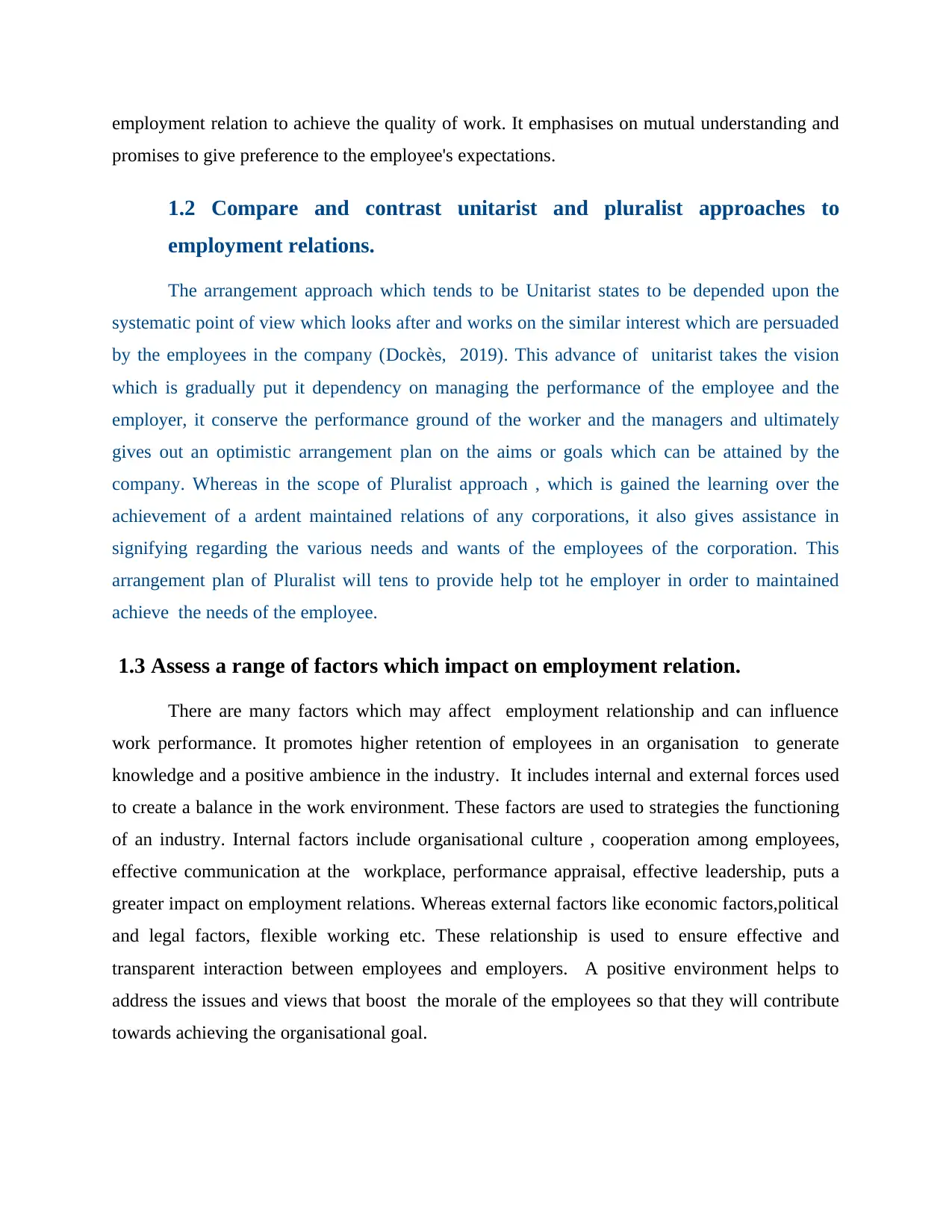
employment relation to achieve the quality of work. It emphasises on mutual understanding and
promises to give preference to the employee's expectations.
1.2 Compare and contrast unitarist and pluralist approaches to
employment relations.
The arrangement approach which tends to be Unitarist states to be depended upon the
systematic point of view which looks after and works on the similar interest which are persuaded
by the employees in the company (Dockès, 2019). This advance of unitarist takes the vision
which is gradually put it dependency on managing the performance of the employee and the
employer, it conserve the performance ground of the worker and the managers and ultimately
gives out an optimistic arrangement plan on the aims or goals which can be attained by the
company. Whereas in the scope of Pluralist approach , which is gained the learning over the
achievement of a ardent maintained relations of any corporations, it also gives assistance in
signifying regarding the various needs and wants of the employees of the corporation. This
arrangement plan of Pluralist will tens to provide help tot he employer in order to maintained
achieve the needs of the employee.
1.3 Assess a range of factors which impact on employment relation.
There are many factors which may affect employment relationship and can influence
work performance. It promotes higher retention of employees in an organisation to generate
knowledge and a positive ambience in the industry. It includes internal and external forces used
to create a balance in the work environment. These factors are used to strategies the functioning
of an industry. Internal factors include organisational culture , cooperation among employees,
effective communication at the workplace, performance appraisal, effective leadership, puts a
greater impact on employment relations. Whereas external factors like economic factors,political
and legal factors, flexible working etc. These relationship is used to ensure effective and
transparent interaction between employees and employers. A positive environment helps to
address the issues and views that boost the morale of the employees so that they will contribute
towards achieving the organisational goal.
promises to give preference to the employee's expectations.
1.2 Compare and contrast unitarist and pluralist approaches to
employment relations.
The arrangement approach which tends to be Unitarist states to be depended upon the
systematic point of view which looks after and works on the similar interest which are persuaded
by the employees in the company (Dockès, 2019). This advance of unitarist takes the vision
which is gradually put it dependency on managing the performance of the employee and the
employer, it conserve the performance ground of the worker and the managers and ultimately
gives out an optimistic arrangement plan on the aims or goals which can be attained by the
company. Whereas in the scope of Pluralist approach , which is gained the learning over the
achievement of a ardent maintained relations of any corporations, it also gives assistance in
signifying regarding the various needs and wants of the employees of the corporation. This
arrangement plan of Pluralist will tens to provide help tot he employer in order to maintained
achieve the needs of the employee.
1.3 Assess a range of factors which impact on employment relation.
There are many factors which may affect employment relationship and can influence
work performance. It promotes higher retention of employees in an organisation to generate
knowledge and a positive ambience in the industry. It includes internal and external forces used
to create a balance in the work environment. These factors are used to strategies the functioning
of an industry. Internal factors include organisational culture , cooperation among employees,
effective communication at the workplace, performance appraisal, effective leadership, puts a
greater impact on employment relations. Whereas external factors like economic factors,political
and legal factors, flexible working etc. These relationship is used to ensure effective and
transparent interaction between employees and employers. A positive environment helps to
address the issues and views that boost the morale of the employees so that they will contribute
towards achieving the organisational goal.

2.1 Describe and critique the essential features of the contract of
employment.
Employment provides ways to earn their livelihood and is considered as an economic
activity. An Employment contract comprises of an offer, acceptance , consideration , legal
relationship and many benefits that are associated with the terms of the contract. It comes into
force after consent and formally signing the document by the parties. This contract is binding
upon the parties and its detailed document which describes all the terms and conditions of the
parties. In other words, it provides details about the parties and job information, benefits and
compensation and the time period of employment and many clauses. It covers all the important
basic details that are binding and enforceable and should be effective. The parties involved in it
are bound to comply of terms of the contract. The parties shall be aware of the condition
imposed on the employees and agree to oblige with it.
2.2 Identify and analyse the main sources of UK and EU employment
relation law making.
Employment law comes into force through various sources of law and derived mainly by
the Acts of Parliament. An agreement was take place between the UK and EU to maintain future
relationship to enforce the employment law and rights of the workers. In this agreement ,
various policies has been laid down to provide directive and regulation to member states and
bound them in the field of employment. The UK has experiences drastic growth in providing the
employment provision and implement the common law to regulate the employment protection
legislation. It provides substantial laws to give effects to the employment relationship so that
they are productive and efficient at working environment. The employees are responsible for the
supplies of service in the organisation so it is important to secure their interest. There are various
forums in the UK which resolve various dispute that arises due to the dispute between the
employment and employees. The UK and EU were made various legislation which provide
protection to the self employed worker and employees. It focuses on the ensure their general
interest so that they can help in the achievement of organisational goals. Worker are said to be
important factor who are responsible to provide efficiency in the working system.
employment.
Employment provides ways to earn their livelihood and is considered as an economic
activity. An Employment contract comprises of an offer, acceptance , consideration , legal
relationship and many benefits that are associated with the terms of the contract. It comes into
force after consent and formally signing the document by the parties. This contract is binding
upon the parties and its detailed document which describes all the terms and conditions of the
parties. In other words, it provides details about the parties and job information, benefits and
compensation and the time period of employment and many clauses. It covers all the important
basic details that are binding and enforceable and should be effective. The parties involved in it
are bound to comply of terms of the contract. The parties shall be aware of the condition
imposed on the employees and agree to oblige with it.
2.2 Identify and analyse the main sources of UK and EU employment
relation law making.
Employment law comes into force through various sources of law and derived mainly by
the Acts of Parliament. An agreement was take place between the UK and EU to maintain future
relationship to enforce the employment law and rights of the workers. In this agreement ,
various policies has been laid down to provide directive and regulation to member states and
bound them in the field of employment. The UK has experiences drastic growth in providing the
employment provision and implement the common law to regulate the employment protection
legislation. It provides substantial laws to give effects to the employment relationship so that
they are productive and efficient at working environment. The employees are responsible for the
supplies of service in the organisation so it is important to secure their interest. There are various
forums in the UK which resolve various dispute that arises due to the dispute between the
employment and employees. The UK and EU were made various legislation which provide
protection to the self employed worker and employees. It focuses on the ensure their general
interest so that they can help in the achievement of organisational goals. Worker are said to be
important factor who are responsible to provide efficiency in the working system.
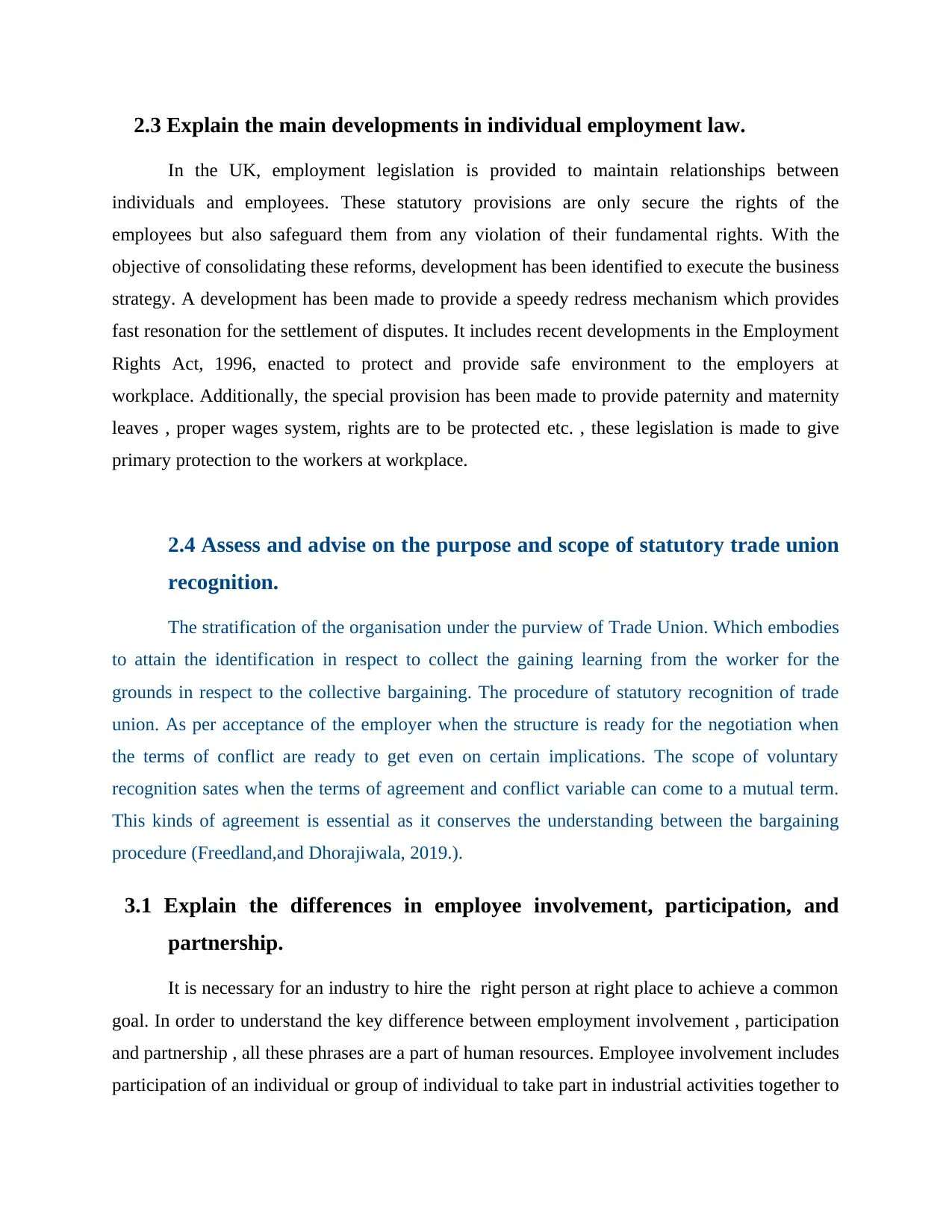
2.3 Explain the main developments in individual employment law.
In the UK, employment legislation is provided to maintain relationships between
individuals and employees. These statutory provisions are only secure the rights of the
employees but also safeguard them from any violation of their fundamental rights. With the
objective of consolidating these reforms, development has been identified to execute the business
strategy. A development has been made to provide a speedy redress mechanism which provides
fast resonation for the settlement of disputes. It includes recent developments in the Employment
Rights Act, 1996, enacted to protect and provide safe environment to the employers at
workplace. Additionally, the special provision has been made to provide paternity and maternity
leaves , proper wages system, rights are to be protected etc. , these legislation is made to give
primary protection to the workers at workplace.
2.4 Assess and advise on the purpose and scope of statutory trade union
recognition.
The stratification of the organisation under the purview of Trade Union. Which embodies
to attain the identification in respect to collect the gaining learning from the worker for the
grounds in respect to the collective bargaining. The procedure of statutory recognition of trade
union. As per acceptance of the employer when the structure is ready for the negotiation when
the terms of conflict are ready to get even on certain implications. The scope of voluntary
recognition sates when the terms of agreement and conflict variable can come to a mutual term.
This kinds of agreement is essential as it conserves the understanding between the bargaining
procedure (Freedland,and Dhorajiwala, 2019.).
3.1 Explain the differences in employee involvement, participation, and
partnership.
It is necessary for an industry to hire the right person at right place to achieve a common
goal. In order to understand the key difference between employment involvement , participation
and partnership , all these phrases are a part of human resources. Employee involvement includes
participation of an individual or group of individual to take part in industrial activities together to
In the UK, employment legislation is provided to maintain relationships between
individuals and employees. These statutory provisions are only secure the rights of the
employees but also safeguard them from any violation of their fundamental rights. With the
objective of consolidating these reforms, development has been identified to execute the business
strategy. A development has been made to provide a speedy redress mechanism which provides
fast resonation for the settlement of disputes. It includes recent developments in the Employment
Rights Act, 1996, enacted to protect and provide safe environment to the employers at
workplace. Additionally, the special provision has been made to provide paternity and maternity
leaves , proper wages system, rights are to be protected etc. , these legislation is made to give
primary protection to the workers at workplace.
2.4 Assess and advise on the purpose and scope of statutory trade union
recognition.
The stratification of the organisation under the purview of Trade Union. Which embodies
to attain the identification in respect to collect the gaining learning from the worker for the
grounds in respect to the collective bargaining. The procedure of statutory recognition of trade
union. As per acceptance of the employer when the structure is ready for the negotiation when
the terms of conflict are ready to get even on certain implications. The scope of voluntary
recognition sates when the terms of agreement and conflict variable can come to a mutual term.
This kinds of agreement is essential as it conserves the understanding between the bargaining
procedure (Freedland,and Dhorajiwala, 2019.).
3.1 Explain the differences in employee involvement, participation, and
partnership.
It is necessary for an industry to hire the right person at right place to achieve a common
goal. In order to understand the key difference between employment involvement , participation
and partnership , all these phrases are a part of human resources. Employee involvement includes
participation of an individual or group of individual to take part in industrial activities together to
Paraphrase This Document
Need a fresh take? Get an instant paraphrase of this document with our AI Paraphraser
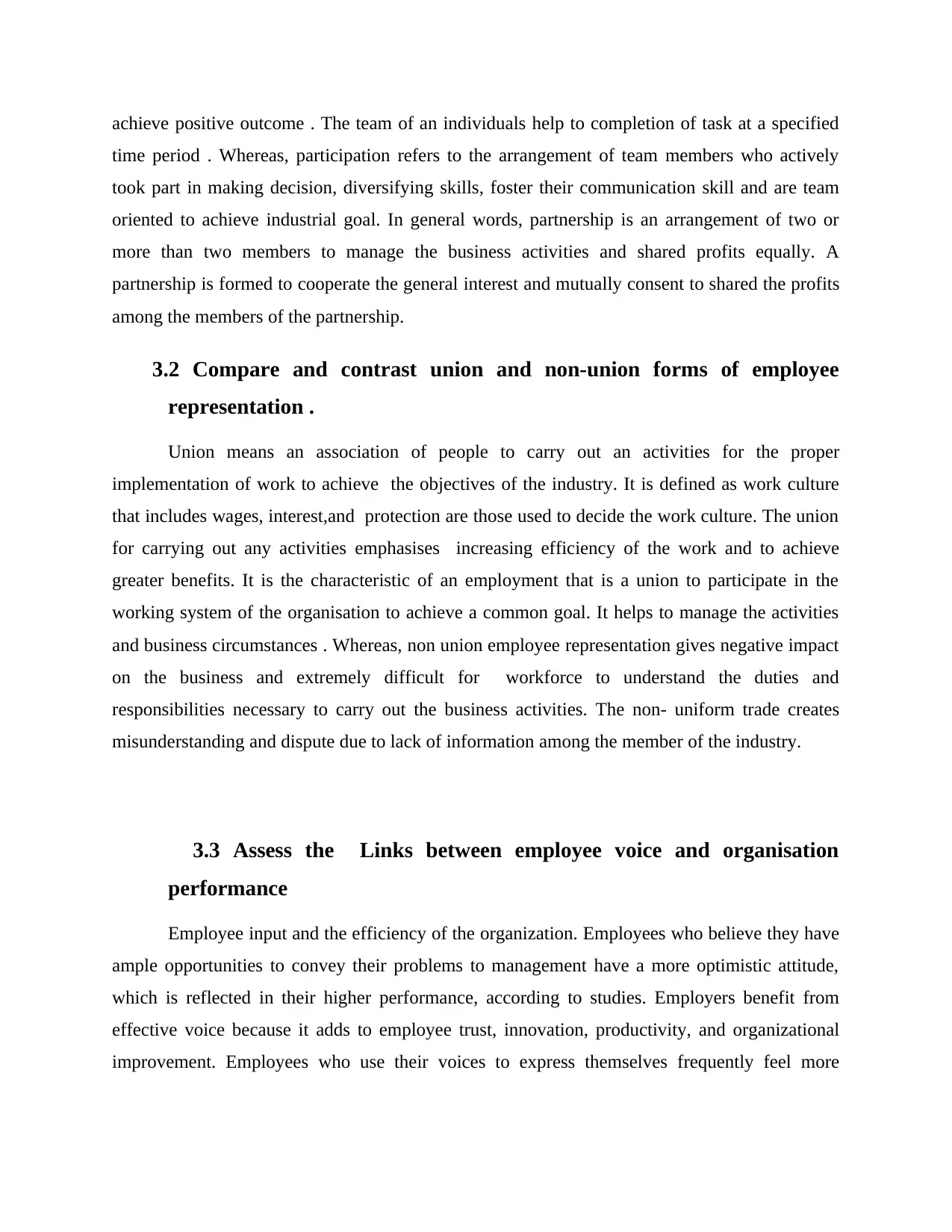
achieve positive outcome . The team of an individuals help to completion of task at a specified
time period . Whereas, participation refers to the arrangement of team members who actively
took part in making decision, diversifying skills, foster their communication skill and are team
oriented to achieve industrial goal. In general words, partnership is an arrangement of two or
more than two members to manage the business activities and shared profits equally. A
partnership is formed to cooperate the general interest and mutually consent to shared the profits
among the members of the partnership.
3.2 Compare and contrast union and non-union forms of employee
representation .
Union means an association of people to carry out an activities for the proper
implementation of work to achieve the objectives of the industry. It is defined as work culture
that includes wages, interest,and protection are those used to decide the work culture. The union
for carrying out any activities emphasises increasing efficiency of the work and to achieve
greater benefits. It is the characteristic of an employment that is a union to participate in the
working system of the organisation to achieve a common goal. It helps to manage the activities
and business circumstances . Whereas, non union employee representation gives negative impact
on the business and extremely difficult for workforce to understand the duties and
responsibilities necessary to carry out the business activities. The non- uniform trade creates
misunderstanding and dispute due to lack of information among the member of the industry.
3.3 Assess the Links between employee voice and organisation
performance
Employee input and the efficiency of the organization. Employees who believe they have
ample opportunities to convey their problems to management have a more optimistic attitude,
which is reflected in their higher performance, according to studies. Employers benefit from
effective voice because it adds to employee trust, innovation, productivity, and organizational
improvement. Employees who use their voices to express themselves frequently feel more
time period . Whereas, participation refers to the arrangement of team members who actively
took part in making decision, diversifying skills, foster their communication skill and are team
oriented to achieve industrial goal. In general words, partnership is an arrangement of two or
more than two members to manage the business activities and shared profits equally. A
partnership is formed to cooperate the general interest and mutually consent to shared the profits
among the members of the partnership.
3.2 Compare and contrast union and non-union forms of employee
representation .
Union means an association of people to carry out an activities for the proper
implementation of work to achieve the objectives of the industry. It is defined as work culture
that includes wages, interest,and protection are those used to decide the work culture. The union
for carrying out any activities emphasises increasing efficiency of the work and to achieve
greater benefits. It is the characteristic of an employment that is a union to participate in the
working system of the organisation to achieve a common goal. It helps to manage the activities
and business circumstances . Whereas, non union employee representation gives negative impact
on the business and extremely difficult for workforce to understand the duties and
responsibilities necessary to carry out the business activities. The non- uniform trade creates
misunderstanding and dispute due to lack of information among the member of the industry.
3.3 Assess the Links between employee voice and organisation
performance
Employee input and the efficiency of the organization. Employees who believe they have
ample opportunities to convey their problems to management have a more optimistic attitude,
which is reflected in their higher performance, according to studies. Employers benefit from
effective voice because it adds to employee trust, innovation, productivity, and organizational
improvement. Employees who use their voices to express themselves frequently feel more

respected, have more job satisfaction, have more power, and have more prospects for
advancement (Streeck and Yamamura, 2018).
Recommendations:
1. Any organization should use employee voice as an important tool because it can enhance
its performance by improving the branding and management of the reputation will take
place. The employee can adapt to the dynamic conditions of the market which will result
in agile behavior. Because promoting and encouraging employee voice can improve
productivity. It can also promote trust worthy conversations thus employee voice
inclusion in the business or organization is recommended.
2. The union approach in any organization is the better option to adopt and include because
it will build trust and honestly among the employees in the organization. The workforce
will become cooperating towards each other. They are recommended for identifying poor
working conditions and making them better for the workforce. Decision making develops
due to discussions with the union representatives thus making a organization successful
and it is also recommended to promote equality among the employees of organization.
advancement (Streeck and Yamamura, 2018).
Recommendations:
1. Any organization should use employee voice as an important tool because it can enhance
its performance by improving the branding and management of the reputation will take
place. The employee can adapt to the dynamic conditions of the market which will result
in agile behavior. Because promoting and encouraging employee voice can improve
productivity. It can also promote trust worthy conversations thus employee voice
inclusion in the business or organization is recommended.
2. The union approach in any organization is the better option to adopt and include because
it will build trust and honestly among the employees in the organization. The workforce
will become cooperating towards each other. They are recommended for identifying poor
working conditions and making them better for the workforce. Decision making develops
due to discussions with the union representatives thus making a organization successful
and it is also recommended to promote equality among the employees of organization.
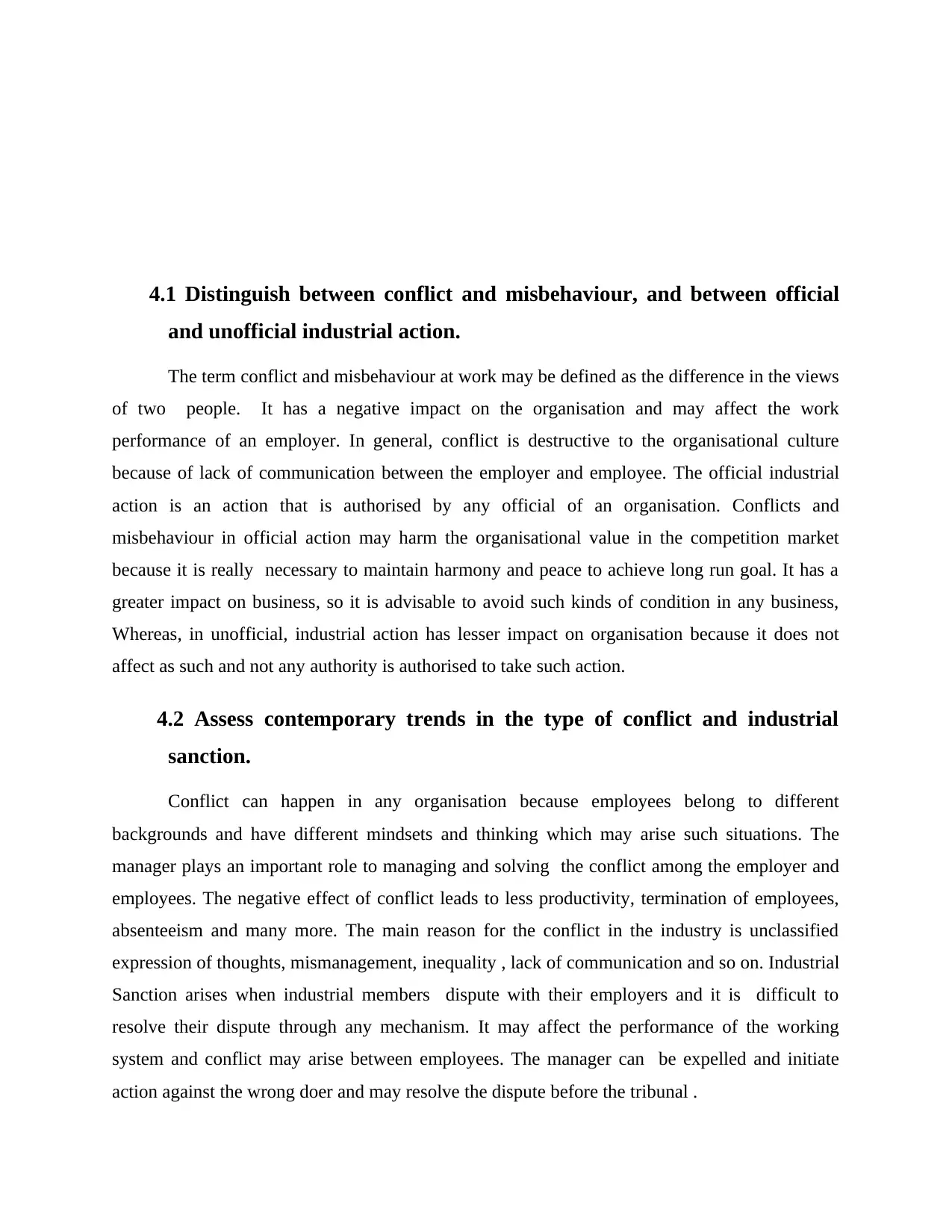
4.1 Distinguish between conflict and misbehaviour, and between official
and unofficial industrial action.
The term conflict and misbehaviour at work may be defined as the difference in the views
of two people. It has a negative impact on the organisation and may affect the work
performance of an employer. In general, conflict is destructive to the organisational culture
because of lack of communication between the employer and employee. The official industrial
action is an action that is authorised by any official of an organisation. Conflicts and
misbehaviour in official action may harm the organisational value in the competition market
because it is really necessary to maintain harmony and peace to achieve long run goal. It has a
greater impact on business, so it is advisable to avoid such kinds of condition in any business,
Whereas, in unofficial, industrial action has lesser impact on organisation because it does not
affect as such and not any authority is authorised to take such action.
4.2 Assess contemporary trends in the type of conflict and industrial
sanction.
Conflict can happen in any organisation because employees belong to different
backgrounds and have different mindsets and thinking which may arise such situations. The
manager plays an important role to managing and solving the conflict among the employer and
employees. The negative effect of conflict leads to less productivity, termination of employees,
absenteeism and many more. The main reason for the conflict in the industry is unclassified
expression of thoughts, mismanagement, inequality , lack of communication and so on. Industrial
Sanction arises when industrial members dispute with their employers and it is difficult to
resolve their dispute through any mechanism. It may affect the performance of the working
system and conflict may arise between employees. The manager can be expelled and initiate
action against the wrong doer and may resolve the dispute before the tribunal .
and unofficial industrial action.
The term conflict and misbehaviour at work may be defined as the difference in the views
of two people. It has a negative impact on the organisation and may affect the work
performance of an employer. In general, conflict is destructive to the organisational culture
because of lack of communication between the employer and employee. The official industrial
action is an action that is authorised by any official of an organisation. Conflicts and
misbehaviour in official action may harm the organisational value in the competition market
because it is really necessary to maintain harmony and peace to achieve long run goal. It has a
greater impact on business, so it is advisable to avoid such kinds of condition in any business,
Whereas, in unofficial, industrial action has lesser impact on organisation because it does not
affect as such and not any authority is authorised to take such action.
4.2 Assess contemporary trends in the type of conflict and industrial
sanction.
Conflict can happen in any organisation because employees belong to different
backgrounds and have different mindsets and thinking which may arise such situations. The
manager plays an important role to managing and solving the conflict among the employer and
employees. The negative effect of conflict leads to less productivity, termination of employees,
absenteeism and many more. The main reason for the conflict in the industry is unclassified
expression of thoughts, mismanagement, inequality , lack of communication and so on. Industrial
Sanction arises when industrial members dispute with their employers and it is difficult to
resolve their dispute through any mechanism. It may affect the performance of the working
system and conflict may arise between employees. The manager can be expelled and initiate
action against the wrong doer and may resolve the dispute before the tribunal .
Secure Best Marks with AI Grader
Need help grading? Try our AI Grader for instant feedback on your assignments.
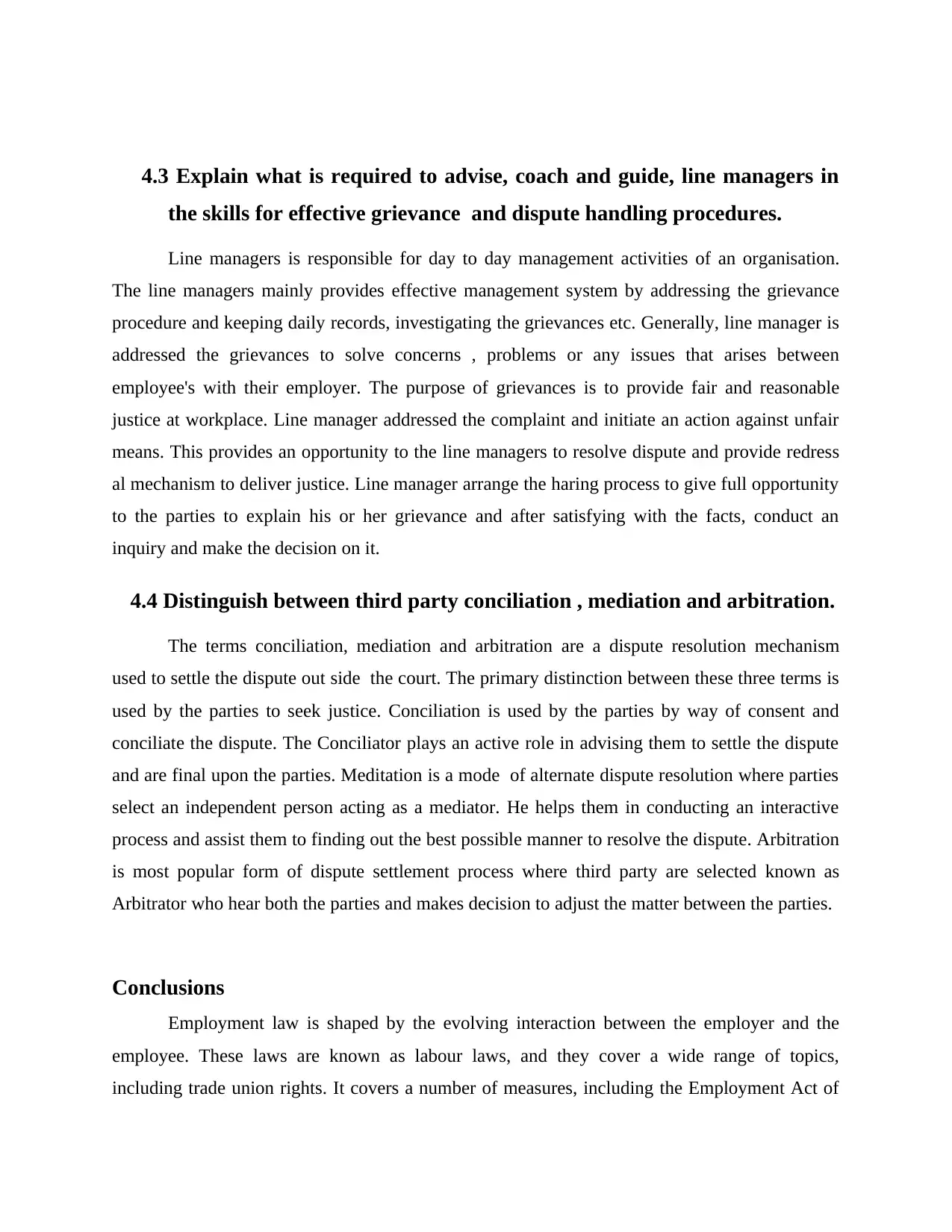
4.3 Explain what is required to advise, coach and guide, line managers in
the skills for effective grievance and dispute handling procedures.
Line managers is responsible for day to day management activities of an organisation.
The line managers mainly provides effective management system by addressing the grievance
procedure and keeping daily records, investigating the grievances etc. Generally, line manager is
addressed the grievances to solve concerns , problems or any issues that arises between
employee's with their employer. The purpose of grievances is to provide fair and reasonable
justice at workplace. Line manager addressed the complaint and initiate an action against unfair
means. This provides an opportunity to the line managers to resolve dispute and provide redress
al mechanism to deliver justice. Line manager arrange the haring process to give full opportunity
to the parties to explain his or her grievance and after satisfying with the facts, conduct an
inquiry and make the decision on it.
4.4 Distinguish between third party conciliation , mediation and arbitration.
The terms conciliation, mediation and arbitration are a dispute resolution mechanism
used to settle the dispute out side the court. The primary distinction between these three terms is
used by the parties to seek justice. Conciliation is used by the parties by way of consent and
conciliate the dispute. The Conciliator plays an active role in advising them to settle the dispute
and are final upon the parties. Meditation is a mode of alternate dispute resolution where parties
select an independent person acting as a mediator. He helps them in conducting an interactive
process and assist them to finding out the best possible manner to resolve the dispute. Arbitration
is most popular form of dispute settlement process where third party are selected known as
Arbitrator who hear both the parties and makes decision to adjust the matter between the parties.
Conclusions
Employment law is shaped by the evolving interaction between the employer and the
employee. These laws are known as labour laws, and they cover a wide range of topics,
including trade union rights. It covers a number of measures, including the Employment Act of
the skills for effective grievance and dispute handling procedures.
Line managers is responsible for day to day management activities of an organisation.
The line managers mainly provides effective management system by addressing the grievance
procedure and keeping daily records, investigating the grievances etc. Generally, line manager is
addressed the grievances to solve concerns , problems or any issues that arises between
employee's with their employer. The purpose of grievances is to provide fair and reasonable
justice at workplace. Line manager addressed the complaint and initiate an action against unfair
means. This provides an opportunity to the line managers to resolve dispute and provide redress
al mechanism to deliver justice. Line manager arrange the haring process to give full opportunity
to the parties to explain his or her grievance and after satisfying with the facts, conduct an
inquiry and make the decision on it.
4.4 Distinguish between third party conciliation , mediation and arbitration.
The terms conciliation, mediation and arbitration are a dispute resolution mechanism
used to settle the dispute out side the court. The primary distinction between these three terms is
used by the parties to seek justice. Conciliation is used by the parties by way of consent and
conciliate the dispute. The Conciliator plays an active role in advising them to settle the dispute
and are final upon the parties. Meditation is a mode of alternate dispute resolution where parties
select an independent person acting as a mediator. He helps them in conducting an interactive
process and assist them to finding out the best possible manner to resolve the dispute. Arbitration
is most popular form of dispute settlement process where third party are selected known as
Arbitrator who hear both the parties and makes decision to adjust the matter between the parties.
Conclusions
Employment law is shaped by the evolving interaction between the employer and the
employee. These laws are known as labour laws, and they cover a wide range of topics,
including trade union rights. It covers a number of measures, including the Employment Act of
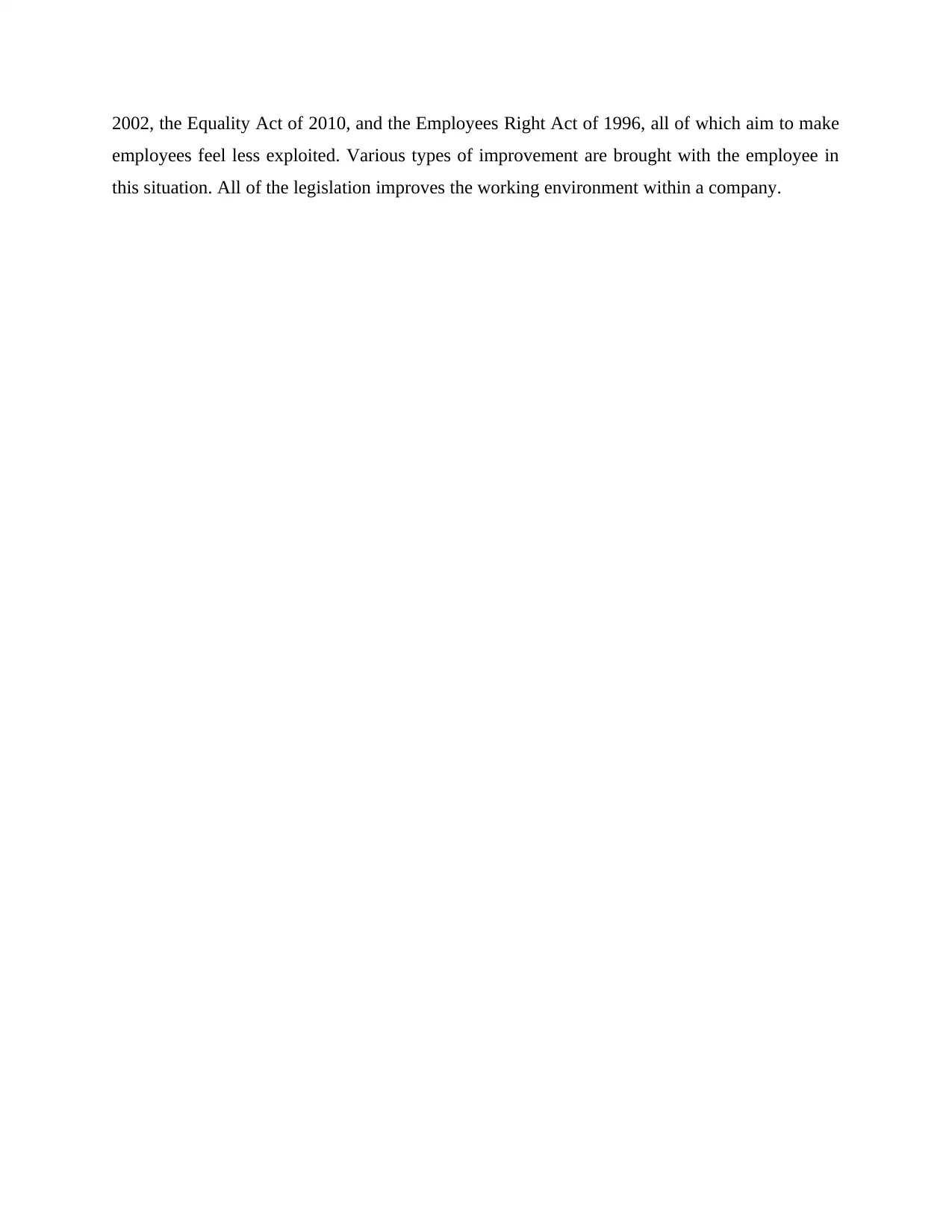
2002, the Equality Act of 2010, and the Employees Right Act of 1996, all of which aim to make
employees feel less exploited. Various types of improvement are brought with the employee in
this situation. All of the legislation improves the working environment within a company.
employees feel less exploited. Various types of improvement are brought with the employee in
this situation. All of the legislation improves the working environment within a company.
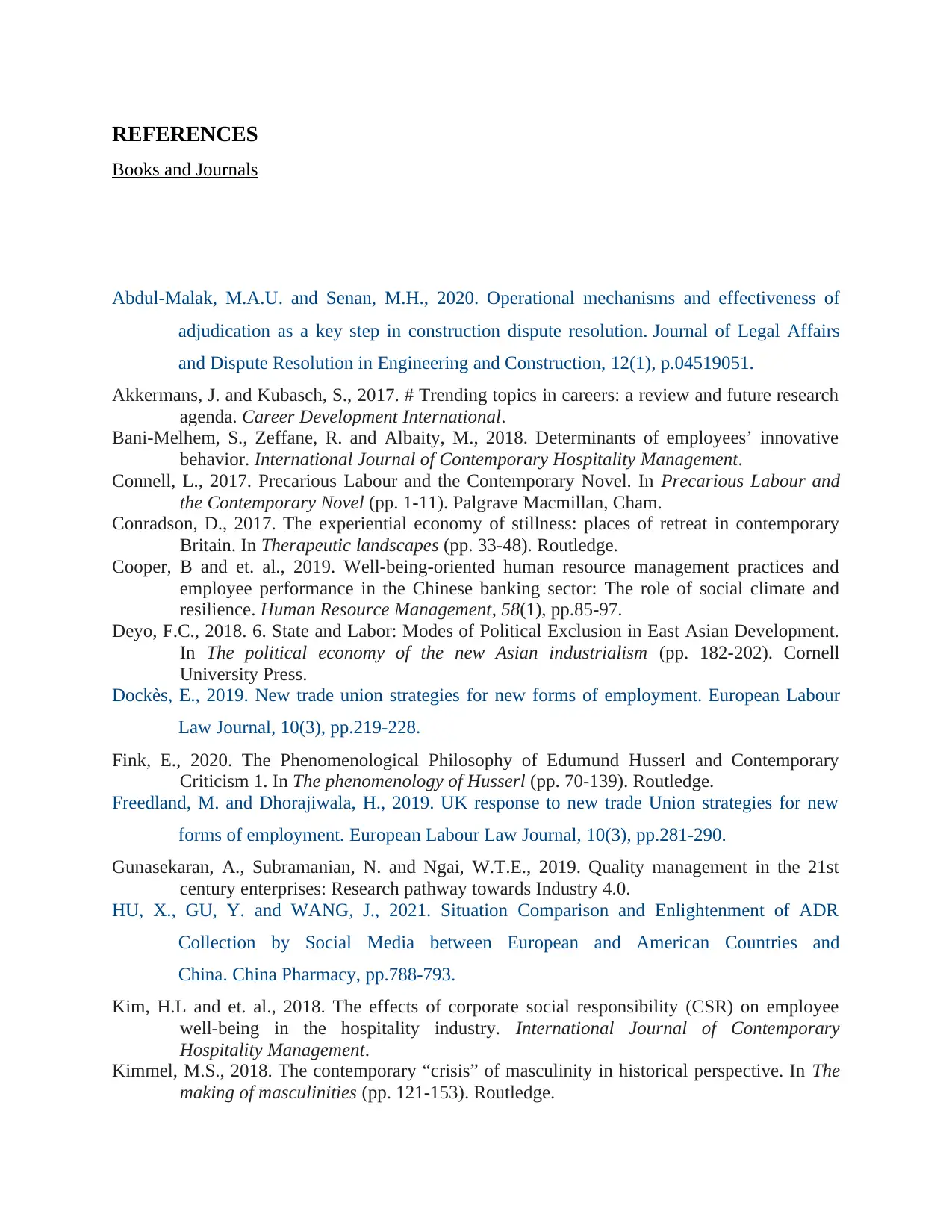
REFERENCES
Books and Journals
Abdul-Malak, M.A.U. and Senan, M.H., 2020. Operational mechanisms and effectiveness of
adjudication as a key step in construction dispute resolution. Journal of Legal Affairs
and Dispute Resolution in Engineering and Construction, 12(1), p.04519051.
Akkermans, J. and Kubasch, S., 2017. # Trending topics in careers: a review and future research
agenda. Career Development International.
Bani-Melhem, S., Zeffane, R. and Albaity, M., 2018. Determinants of employees’ innovative
behavior. International Journal of Contemporary Hospitality Management.
Connell, L., 2017. Precarious Labour and the Contemporary Novel. In Precarious Labour and
the Contemporary Novel (pp. 1-11). Palgrave Macmillan, Cham.
Conradson, D., 2017. The experiential economy of stillness: places of retreat in contemporary
Britain. In Therapeutic landscapes (pp. 33-48). Routledge.
Cooper, B and et. al., 2019. Well‐being‐oriented human resource management practices and
employee performance in the Chinese banking sector: The role of social climate and
resilience. Human Resource Management, 58(1), pp.85-97.
Deyo, F.C., 2018. 6. State and Labor: Modes of Political Exclusion in East Asian Development.
In The political economy of the new Asian industrialism (pp. 182-202). Cornell
University Press.
Dockès, E., 2019. New trade union strategies for new forms of employment. European Labour
Law Journal, 10(3), pp.219-228.
Fink, E., 2020. The Phenomenological Philosophy of Edumund Husserl and Contemporary
Criticism 1. In The phenomenology of Husserl (pp. 70-139). Routledge.
Freedland, M. and Dhorajiwala, H., 2019. UK response to new trade Union strategies for new
forms of employment. European Labour Law Journal, 10(3), pp.281-290.
Gunasekaran, A., Subramanian, N. and Ngai, W.T.E., 2019. Quality management in the 21st
century enterprises: Research pathway towards Industry 4.0.
HU, X., GU, Y. and WANG, J., 2021. Situation Comparison and Enlightenment of ADR
Collection by Social Media between European and American Countries and
China. China Pharmacy, pp.788-793.
Kim, H.L and et. al., 2018. The effects of corporate social responsibility (CSR) on employee
well-being in the hospitality industry. International Journal of Contemporary
Hospitality Management.
Kimmel, M.S., 2018. The contemporary “crisis” of masculinity in historical perspective. In The
making of masculinities (pp. 121-153). Routledge.
Books and Journals
Abdul-Malak, M.A.U. and Senan, M.H., 2020. Operational mechanisms and effectiveness of
adjudication as a key step in construction dispute resolution. Journal of Legal Affairs
and Dispute Resolution in Engineering and Construction, 12(1), p.04519051.
Akkermans, J. and Kubasch, S., 2017. # Trending topics in careers: a review and future research
agenda. Career Development International.
Bani-Melhem, S., Zeffane, R. and Albaity, M., 2018. Determinants of employees’ innovative
behavior. International Journal of Contemporary Hospitality Management.
Connell, L., 2017. Precarious Labour and the Contemporary Novel. In Precarious Labour and
the Contemporary Novel (pp. 1-11). Palgrave Macmillan, Cham.
Conradson, D., 2017. The experiential economy of stillness: places of retreat in contemporary
Britain. In Therapeutic landscapes (pp. 33-48). Routledge.
Cooper, B and et. al., 2019. Well‐being‐oriented human resource management practices and
employee performance in the Chinese banking sector: The role of social climate and
resilience. Human Resource Management, 58(1), pp.85-97.
Deyo, F.C., 2018. 6. State and Labor: Modes of Political Exclusion in East Asian Development.
In The political economy of the new Asian industrialism (pp. 182-202). Cornell
University Press.
Dockès, E., 2019. New trade union strategies for new forms of employment. European Labour
Law Journal, 10(3), pp.219-228.
Fink, E., 2020. The Phenomenological Philosophy of Edumund Husserl and Contemporary
Criticism 1. In The phenomenology of Husserl (pp. 70-139). Routledge.
Freedland, M. and Dhorajiwala, H., 2019. UK response to new trade Union strategies for new
forms of employment. European Labour Law Journal, 10(3), pp.281-290.
Gunasekaran, A., Subramanian, N. and Ngai, W.T.E., 2019. Quality management in the 21st
century enterprises: Research pathway towards Industry 4.0.
HU, X., GU, Y. and WANG, J., 2021. Situation Comparison and Enlightenment of ADR
Collection by Social Media between European and American Countries and
China. China Pharmacy, pp.788-793.
Kim, H.L and et. al., 2018. The effects of corporate social responsibility (CSR) on employee
well-being in the hospitality industry. International Journal of Contemporary
Hospitality Management.
Kimmel, M.S., 2018. The contemporary “crisis” of masculinity in historical perspective. In The
making of masculinities (pp. 121-153). Routledge.
Paraphrase This Document
Need a fresh take? Get an instant paraphrase of this document with our AI Paraphraser
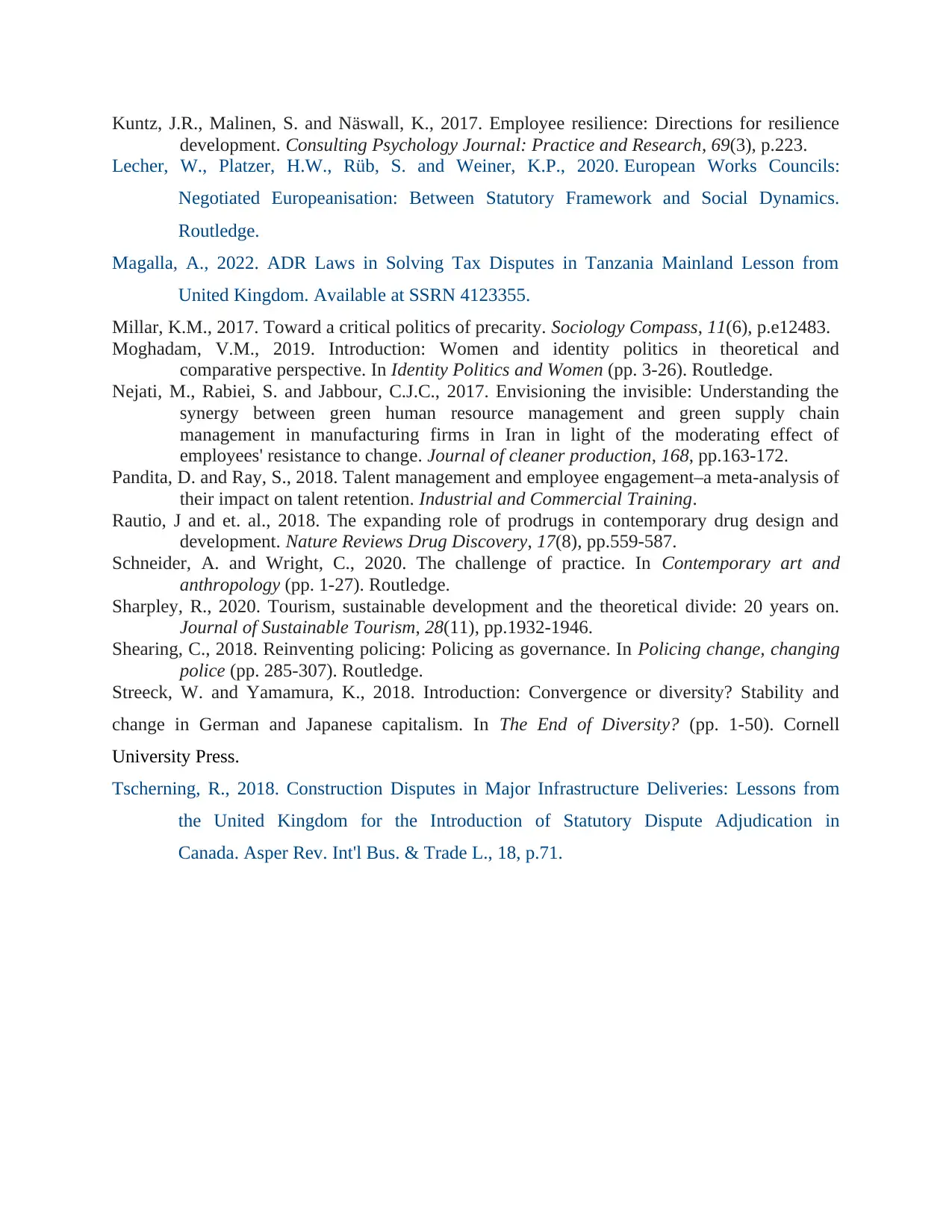
Kuntz, J.R., Malinen, S. and Näswall, K., 2017. Employee resilience: Directions for resilience
development. Consulting Psychology Journal: Practice and Research, 69(3), p.223.
Lecher, W., Platzer, H.W., Rüb, S. and Weiner, K.P., 2020. European Works Councils:
Negotiated Europeanisation: Between Statutory Framework and Social Dynamics.
Routledge.
Magalla, A., 2022. ADR Laws in Solving Tax Disputes in Tanzania Mainland Lesson from
United Kingdom. Available at SSRN 4123355.
Millar, K.M., 2017. Toward a critical politics of precarity. Sociology Compass, 11(6), p.e12483.
Moghadam, V.M., 2019. Introduction: Women and identity politics in theoretical and
comparative perspective. In Identity Politics and Women (pp. 3-26). Routledge.
Nejati, M., Rabiei, S. and Jabbour, C.J.C., 2017. Envisioning the invisible: Understanding the
synergy between green human resource management and green supply chain
management in manufacturing firms in Iran in light of the moderating effect of
employees' resistance to change. Journal of cleaner production, 168, pp.163-172.
Pandita, D. and Ray, S., 2018. Talent management and employee engagement–a meta-analysis of
their impact on talent retention. Industrial and Commercial Training.
Rautio, J and et. al., 2018. The expanding role of prodrugs in contemporary drug design and
development. Nature Reviews Drug Discovery, 17(8), pp.559-587.
Schneider, A. and Wright, C., 2020. The challenge of practice. In Contemporary art and
anthropology (pp. 1-27). Routledge.
Sharpley, R., 2020. Tourism, sustainable development and the theoretical divide: 20 years on.
Journal of Sustainable Tourism, 28(11), pp.1932-1946.
Shearing, C., 2018. Reinventing policing: Policing as governance. In Policing change, changing
police (pp. 285-307). Routledge.
Streeck, W. and Yamamura, K., 2018. Introduction: Convergence or diversity? Stability and
change in German and Japanese capitalism. In The End of Diversity? (pp. 1-50). Cornell
University Press.
Tscherning, R., 2018. Construction Disputes in Major Infrastructure Deliveries: Lessons from
the United Kingdom for the Introduction of Statutory Dispute Adjudication in
Canada. Asper Rev. Int'l Bus. & Trade L., 18, p.71.
development. Consulting Psychology Journal: Practice and Research, 69(3), p.223.
Lecher, W., Platzer, H.W., Rüb, S. and Weiner, K.P., 2020. European Works Councils:
Negotiated Europeanisation: Between Statutory Framework and Social Dynamics.
Routledge.
Magalla, A., 2022. ADR Laws in Solving Tax Disputes in Tanzania Mainland Lesson from
United Kingdom. Available at SSRN 4123355.
Millar, K.M., 2017. Toward a critical politics of precarity. Sociology Compass, 11(6), p.e12483.
Moghadam, V.M., 2019. Introduction: Women and identity politics in theoretical and
comparative perspective. In Identity Politics and Women (pp. 3-26). Routledge.
Nejati, M., Rabiei, S. and Jabbour, C.J.C., 2017. Envisioning the invisible: Understanding the
synergy between green human resource management and green supply chain
management in manufacturing firms in Iran in light of the moderating effect of
employees' resistance to change. Journal of cleaner production, 168, pp.163-172.
Pandita, D. and Ray, S., 2018. Talent management and employee engagement–a meta-analysis of
their impact on talent retention. Industrial and Commercial Training.
Rautio, J and et. al., 2018. The expanding role of prodrugs in contemporary drug design and
development. Nature Reviews Drug Discovery, 17(8), pp.559-587.
Schneider, A. and Wright, C., 2020. The challenge of practice. In Contemporary art and
anthropology (pp. 1-27). Routledge.
Sharpley, R., 2020. Tourism, sustainable development and the theoretical divide: 20 years on.
Journal of Sustainable Tourism, 28(11), pp.1932-1946.
Shearing, C., 2018. Reinventing policing: Policing as governance. In Policing change, changing
police (pp. 285-307). Routledge.
Streeck, W. and Yamamura, K., 2018. Introduction: Convergence or diversity? Stability and
change in German and Japanese capitalism. In The End of Diversity? (pp. 1-50). Cornell
University Press.
Tscherning, R., 2018. Construction Disputes in Major Infrastructure Deliveries: Lessons from
the United Kingdom for the Introduction of Statutory Dispute Adjudication in
Canada. Asper Rev. Int'l Bus. & Trade L., 18, p.71.

1 out of 36
![[object Object]](/_next/static/media/star-bottom.7253800d.svg)





